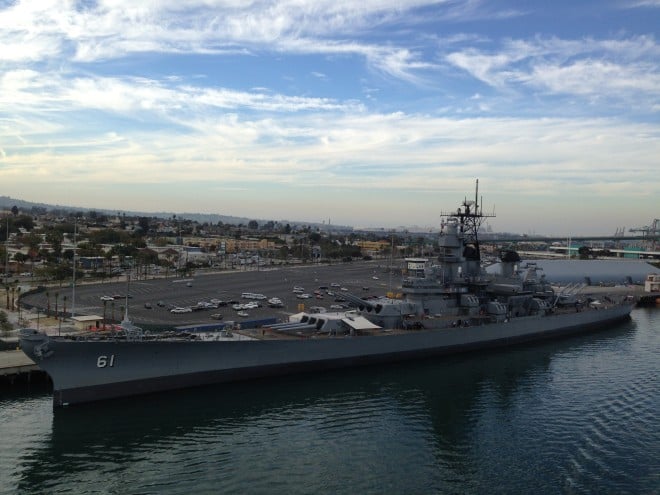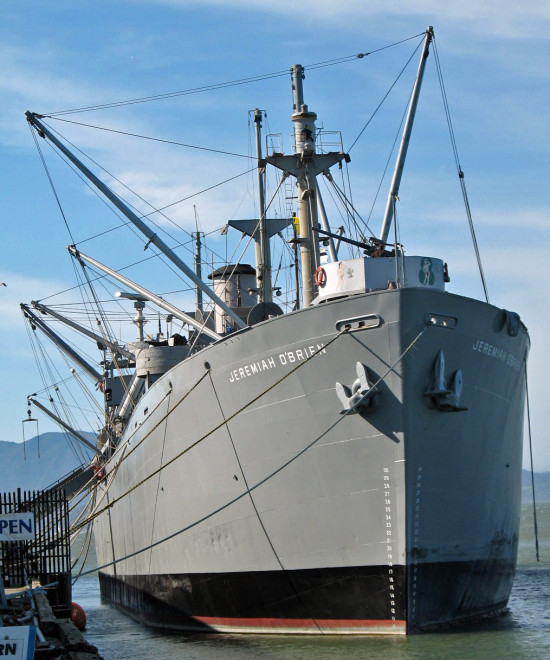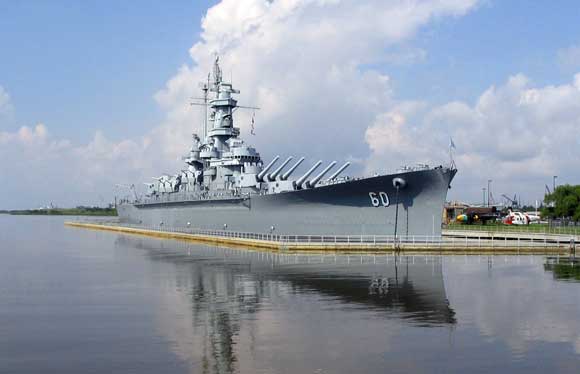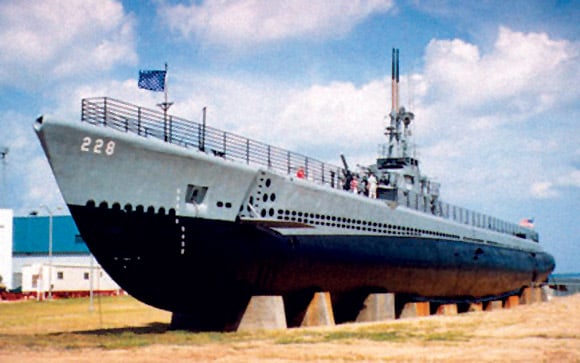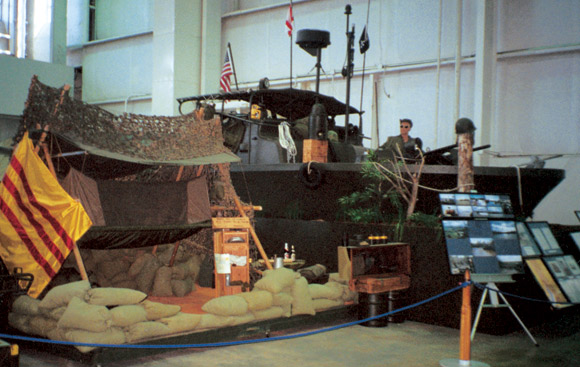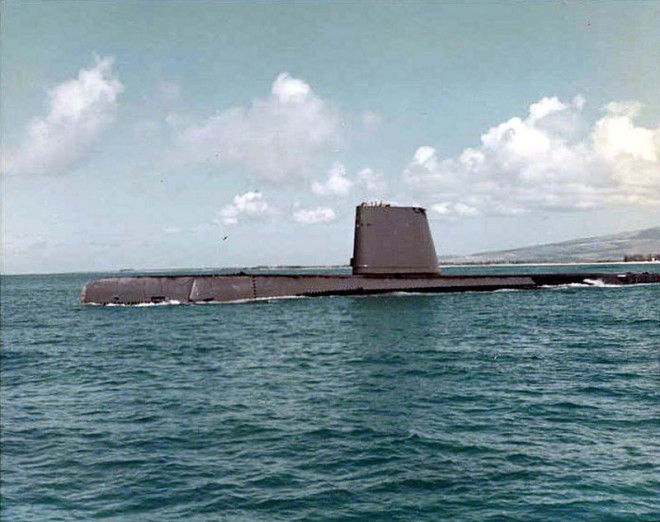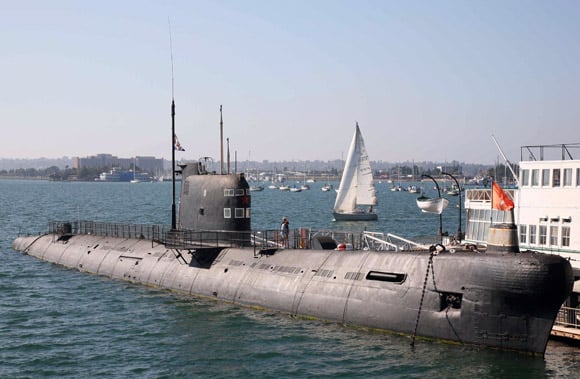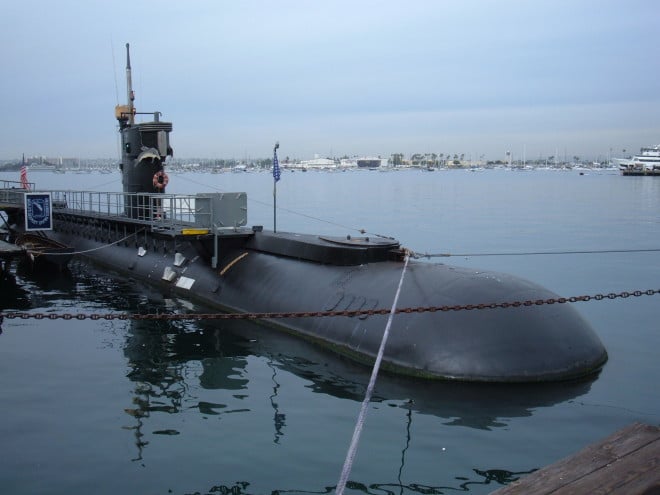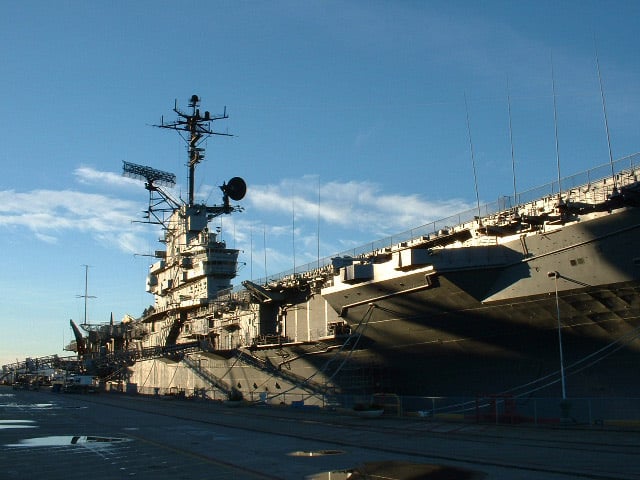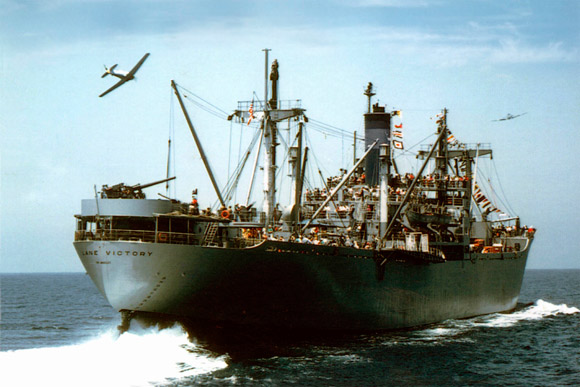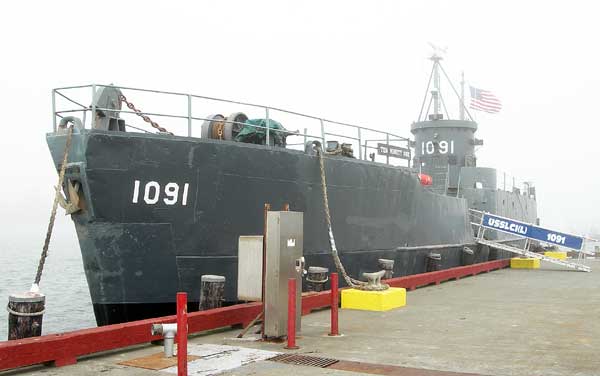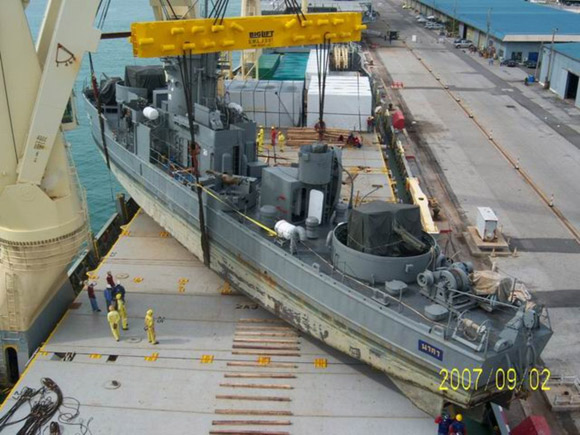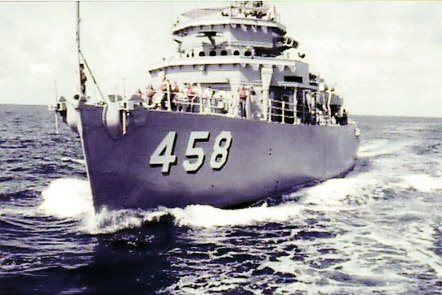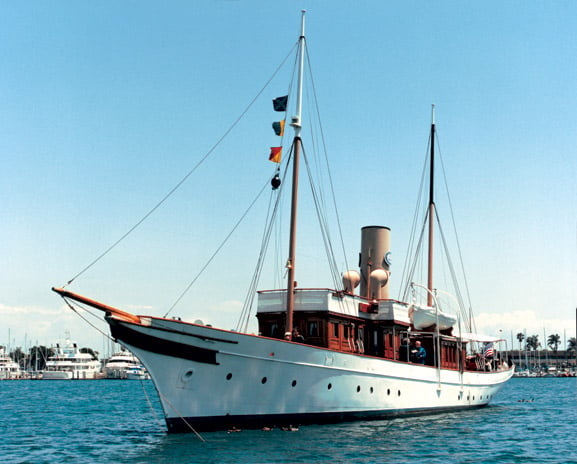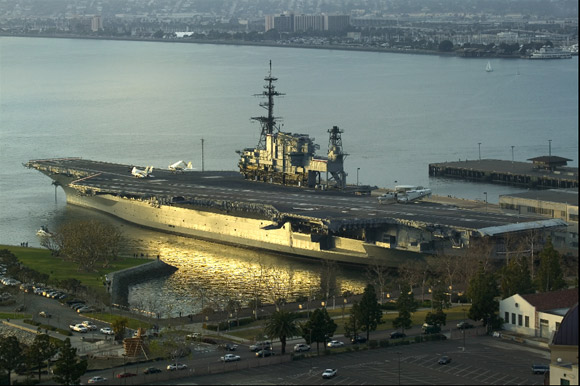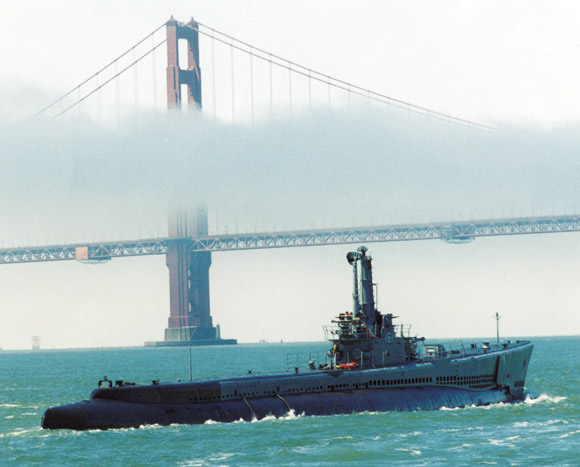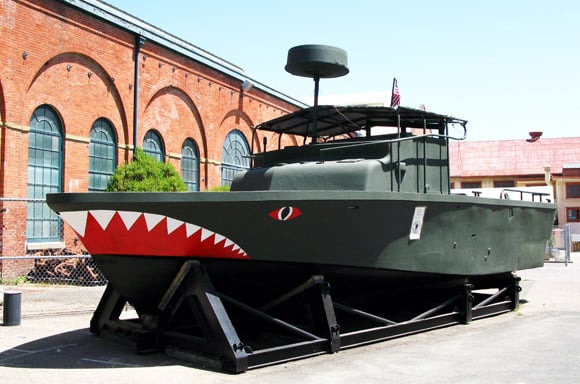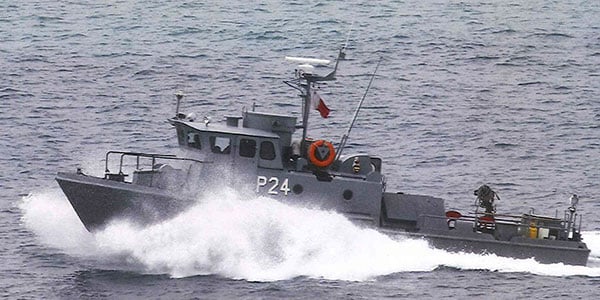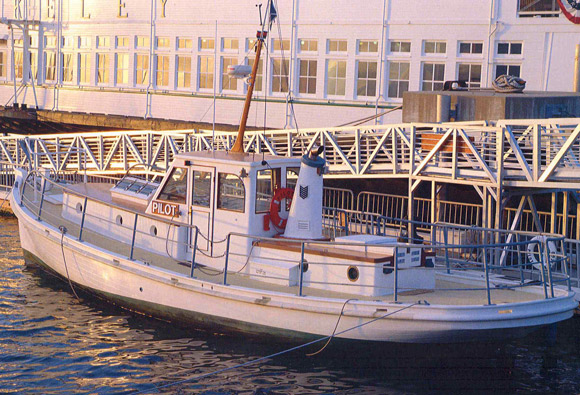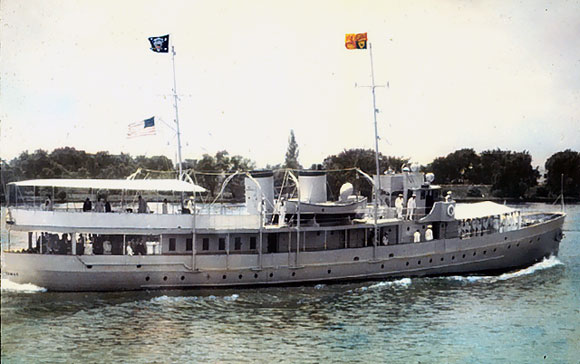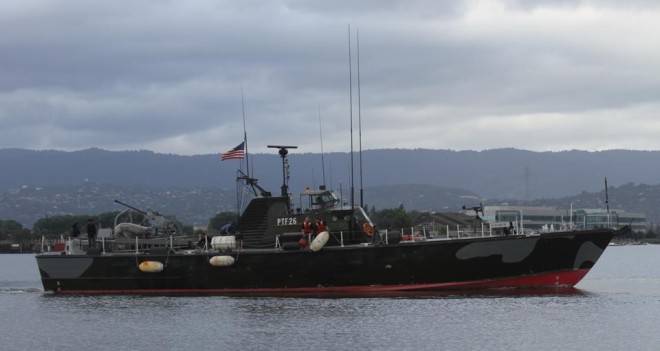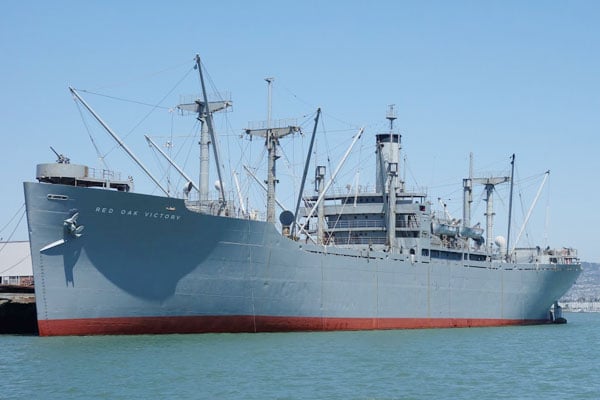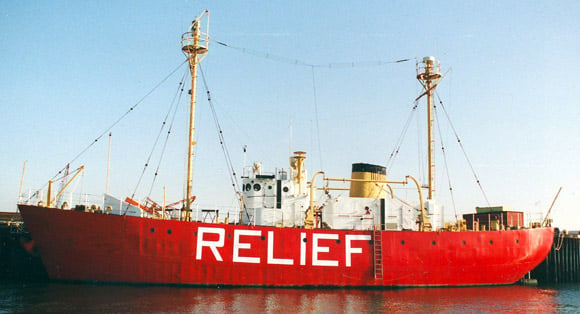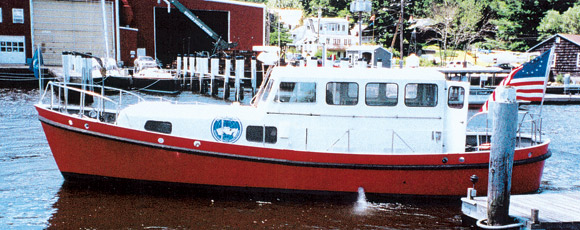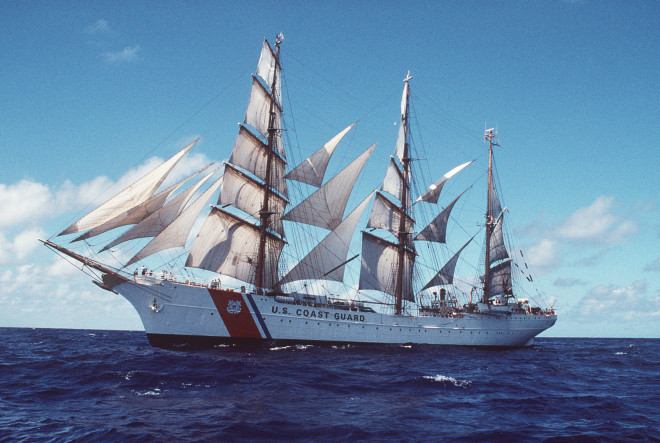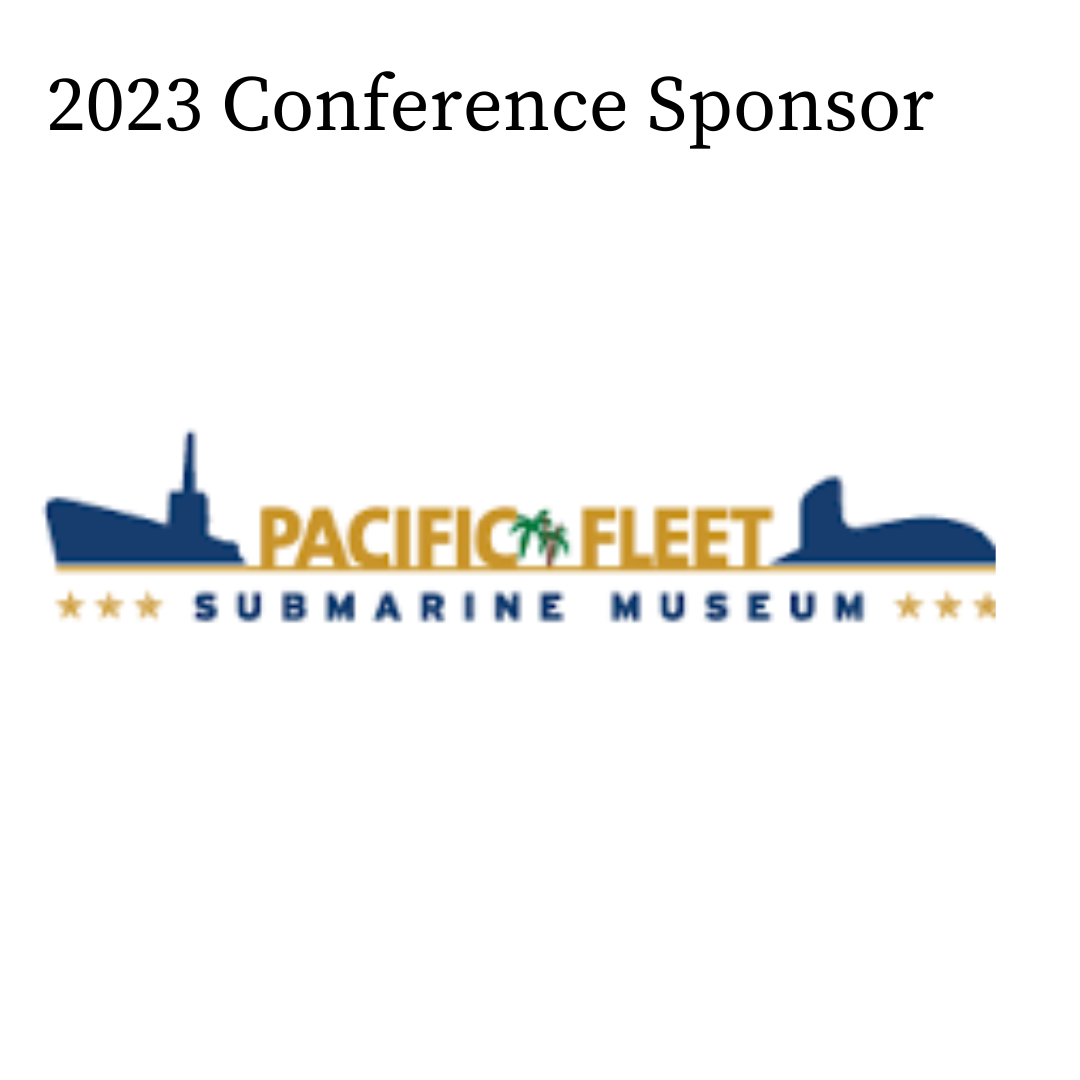San Juan, PR (Feb. 21)–Coast Guard Cutter Eagle under full sail off the coast of Puerto Rico. BROWN, TELFAIR H. PA1
U.S. Coast Guard Academy
45 Mohegan Avenue
New London, Connecticut 06320
(860) 444-8595
FAX (860) 444-8445
http://www.uscga.edu/eagle/
Eagle serves as a seagoing classroom for approximately 175 cadets and instructors from the U.S. Coast Guard Academy. It is on the decks and rigging of Eagle that the young men and women of the Academy get their first taste of salt air and life at sea. Working aloft they meet fear and learn to overcome it. The cadets handle more than 20,000 square feet of sail and five miles of rigging. Over 200 lines must be coordinated during a major ship maneuver, so cadets must learn the name and function of each line.
Japanese HA-8
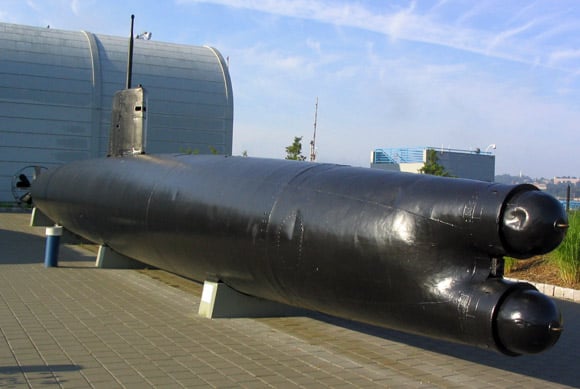
Historic Ship Nautilus & Submarine Force Museum
1 Crystal Lake Road
Groton, CT 06349-5571
(800) 343-0079
(860) 694-3558
Fax: (860) 694-4150
Email: [email protected]
http://www.ussnautilus.org
USS Nautilus (SSN-571)
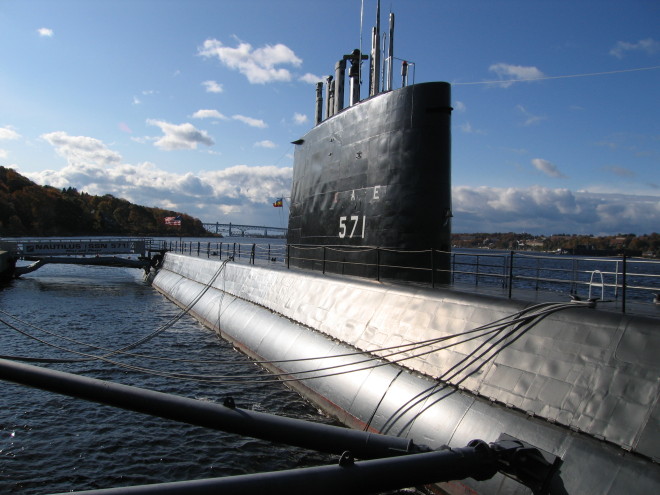
Historic Ship Nautilus & Submarine Force Museum
1 Crystal Lake Road
Groton, CT 06349-5571
(800) 343-0079
(860) 694-3558
Fax: (860) 694-4150
Email: [email protected]
http://www.ussnautilus.org
From Undersea Magazine:
Nautilus was launched into the Thames River on Jan. 21, 1954, after eighteen months of construction. First Lady Mamie Eisenhower broke the traditional bottle of champagne across Nautilus’s bow and Nautilus became the first commissioned nuclear powered ship in the United States Navy. At 11 a.m. EST on the morning of Jan. 17, 1955 the submarine’s first commanding officer, Cmdr. Eugene P. Wilkinson, ordered all lines cast off and signaled the memorable and historic message, “Underway on Nuclear Power.” Over the next several years, Nautilus shattered all submerged speed and distance records.
Italian Siluro San Bartolomeo (SSB)
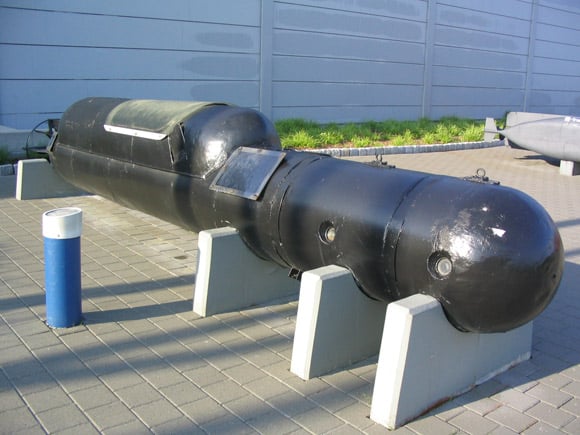
Historic Ship Nautilus & Submarine Force Museum
1 Crystal Lake Road
Groton, CT 06349-5571
(800) 343-0079
(860) 694-3558
Fax: (860) 694-4150
Email: [email protected]
http://www.ussnautilus.org
Siluro San Bartolomeo S.S.B., translated as a “St. Bartholomew Torpedo”, is an Italian submersible used during WW II for commando style operations. To maintain secrecy, the submersible was developed at a remote farm site, and was nicknamed Maiale (“pig”). The first version was officially designated S.L.C. (Siluro A Lenta Corsa: slow running torpedo). Launched from a larger submarine, two men in scuba gear maneuvered from the open cockpit. Once near the ship, they would attach explosives with a timed fuse. Despite their small size, these all battery propelled Maiale‘s achieved effective results early in the war against British ships at Gibraltar, Spain and Alexandria, Egypt. Due to Italy’s surrender in September 1943, the later SSB versions never saw combat.
SS X-1

Historic Ship Nautilus & Submarine Force Museum
1 Crystal Lake Road
Groton, CT 06349-5571
(800) 343-0079
(860) 694-3558
Fax: (860) 694-4150
Email: [email protected]
http://www.ussnautilus.org
SS X-1, the U.S. Navy’s only midget submarine, was built by the Engine Division of Fairfield Engine and Airplane Corporation. It served for research and testing to assist the Navy in evaluating its ability to defend harbors against other small submarines. The tests helped to determine the offensive capabilities and limitations of this type of submersible. It was originally powered by a hydrogen peroxide/diesel engine and battery system. However, an explosion of its fuel supply in May 1957 resulted in its conversion to diesel-electric drive.
Delaware: Lightship Overfalls (LV-118)
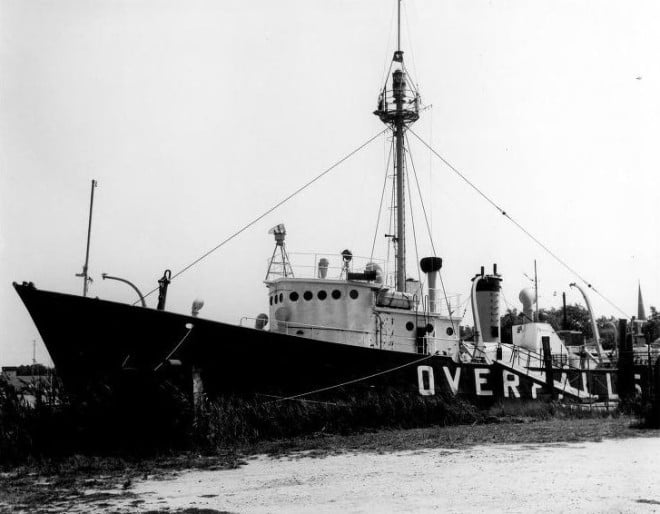
Overfalls Foundation
Post Office Box 413
Lewes, DE 19958-0413
Email: [email protected]
http://www.overfalls.org/
District of Columbia
LCVP
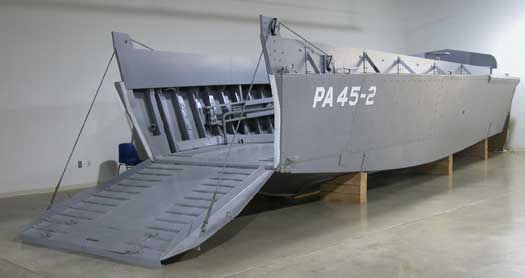
National Museum of the United States Navy
805 Kidder Breese St., SE
Washington Navy Yard, DC 20374-5060
(202) 433-4882
Fax: (202) 433-8200
http://www.history.navy.mil
PCF-1
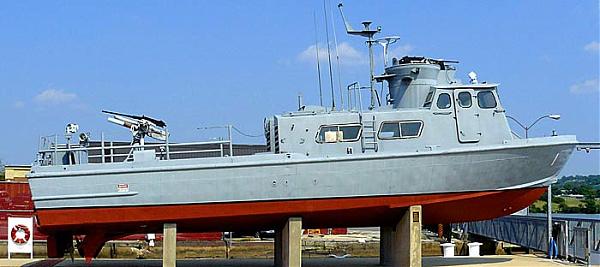
National Museum of the United States Navy
805 Kidder Breese St., SE
Washington Navy Yard, DC 20374-5060
(202) 433-4882
Fax: (202) 433-8200
http://www.history.navy.mil
Continental Gunboat Philadelphia
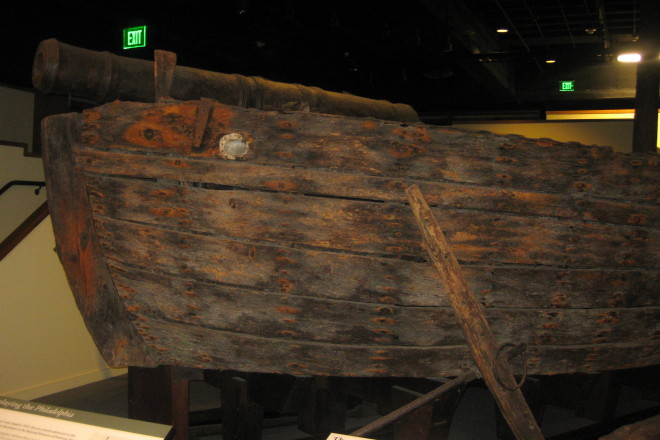
National Museum of American History
Smithsonian Institution
12th Street and Constitution Ave., NW
Washington, DC 20560-0628
(202) 633-3909
Fax: (202) 357-4256
http://americanhistory.si.edu/
RV Trieste
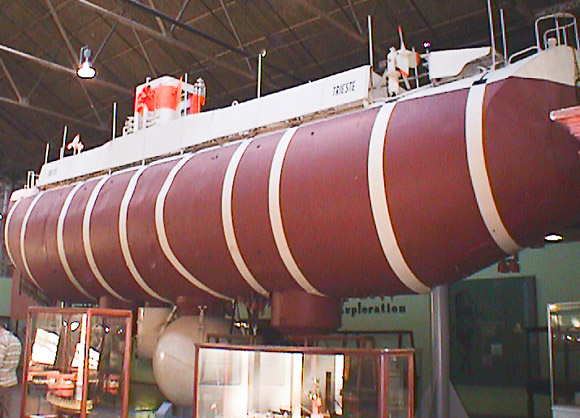
National Museum of the United States Navy
805 Kidder Breese St., SE
Washington Navy Yard, DC 20374-5060
(202) 433-4882
Fax: (202) 433-8200
http://www.history.navy.mil
From Naval Institute Proceedings, Feb. 2014:
This Trieste , which conducted her first dive in April 1968, was so highly classified the Navy initially did not attach a name to the craft. She originally was designed for only one mission: Project Winter Wind, conceived after nose cones from early Soviet intercontinental ballistic missile (ICBM) tests landed in the North Pacific in 1960. Development of methods to conduct precision deep-ocean search and recovery in support of Winter Wind would cost hundreds of millions of dollars from 1963 to 1971, far in excess of initial estimates but with unexpected benefits for the Navy, the United States, and oceanography.
The Trieste ’s participation in Winter Wind effectively ended on 21 May 1968 when the nuclear-powered submarine USSScorpion (SSN-589) was lost in the North Atlantic. The covert bathyscaph was the only operational manned deep-submersible available to the Navy that was capable of diving on the Scorpion wreck.
Florida
SS American Victory
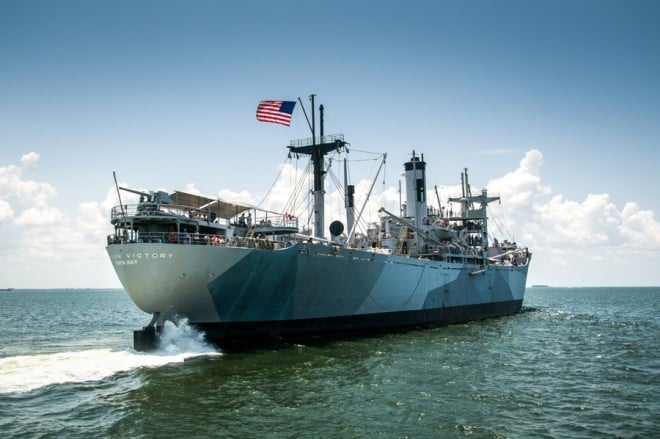
American Victory Mariners Memorial and Museum Ship, Inc.
705 Channelside Drive
Tampa, FL 33602
(813) 228-8766
Fax: (813) 228-8769
E-Mail: [email protected]
http://www.americanvictory.org
USCG Ingham (WPG, WAGC, WHEC-35)
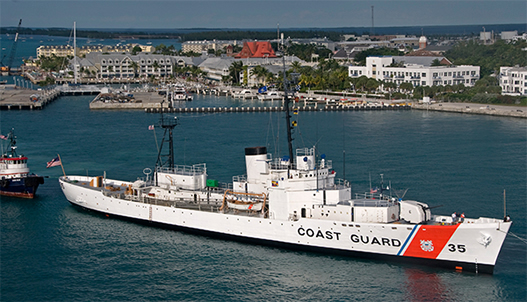
USCGC Ingham Memorial Museum
Truman Waterfront
Post Office Box 186
Key West, Florida 33041
(305) 292-5072
Fax: (786) 268-0969
Email: [email protected]
http://www.uscgcingham.org/index.html
PBR Mark II
National Vietnam War Museum
3400 North Tanner Road
Orlando, FL 32826-3433
(407) 601-2864
Fax: (407) 601-2864
Email: [email protected]
PTF-3
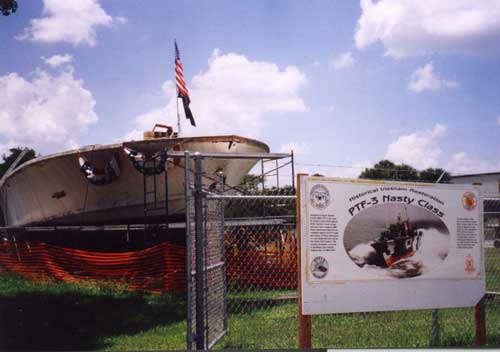
Deland Naval Air Station Museum
910 Biscayne Blvd.
Deland, FL 32724
(386)-775-1224
Fax: (386) 775-1130
Email: [email protected]
http://www.ptf3restoration.org/
Georgia
CSS Chattahoochee
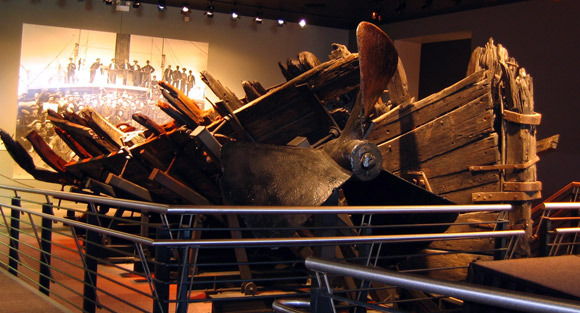
National Civil War Naval Museum at Port Columbus
1002 Victory Drive
Columbus, Georgia 31901
(706) 327-9798
Fax: (706) 324-7225
Email: [email protected]
http://portcolumbus.org/
CSS Jackson
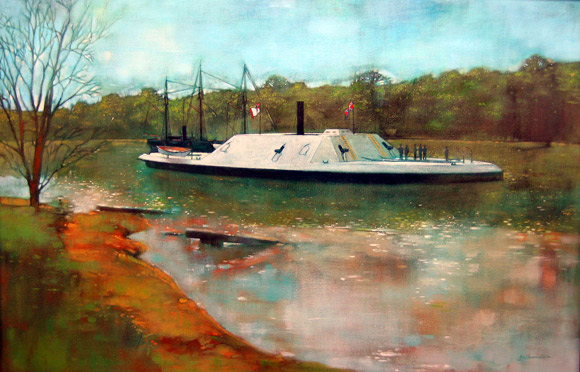
National Civil War Naval Museum at Port Columbus
1002 Victory Drive
Columbus, Georgia 31901
(706) 327-9798
Fax: (706) 324-7225
Email: [email protected]
http://portcolumbus.org/
Hawaii
USS Arizona (BB-39)
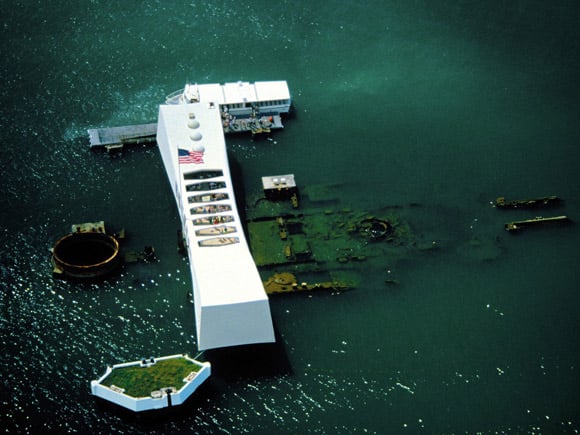
World War II Valor in the Pacific National Monument
National Park Service
1 Arizona Memorial Place
Honolulu, HI 96818-3145
(808) 422-2771
Recorded Message (808) 422-0561
Fax: (808) 483-8608
http://www.nps.gov/valr/index.htm
http://www.pacifichistoricparks.org/
Privately raised funds and a Congressional appropriation built the Arizona Memorial in 1962. This graceful white concrete arch spans the sunken ship and includes a shrine listing the names of Arizona‘s dead, assembly area, and viewing platform. In 1981, another Congressional appropriation built a modern visitor center that serves as a museum, book store, interpretive center, theater and assembly area for the tour boats that carry visitors to the memorial. Operated by the National Park Service, the USS Arizona Memorial serves as a reminder of the tragic events of December 7, 1941, and of the proud battleship that rests beneath the waters of Pearl Harbor.
USS Bowfin (SS-287)
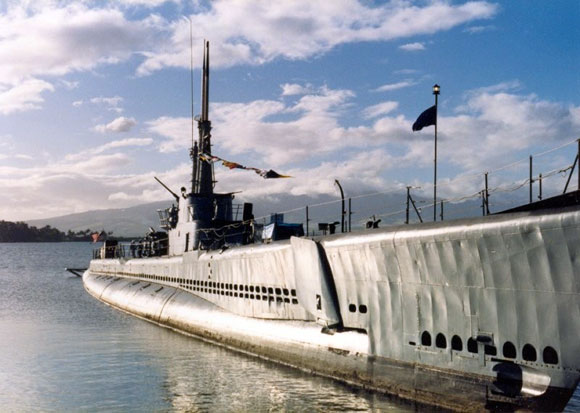
Pacific Fleet Submarine Memorial & Museum
11 Arizona Memorial Drive
Honolulu, HI 96818
(808) 423-1341
Fax: (808) 422-5201
Email: [email protected]
http://www.bowfin.org
Japanese Kaiten
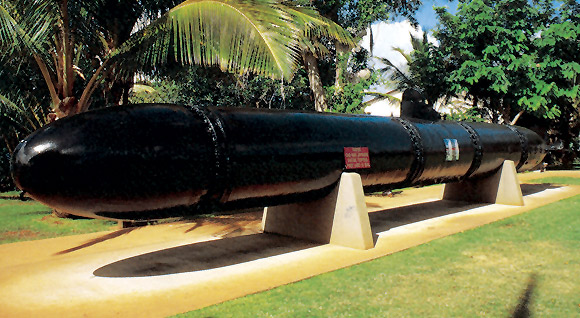
Pacific Fleet Submarine Memorial & Museum
11 Arizona Memorial Drive
Honolulu, HI 96818
(808) 423-1341
Fax: (808) 422-5201
Email: [email protected]
http://www.bowfin.org
From Proceedings, Jan. 1962:
By January 1943, the enlarged Model 93 was now 54 feet long, would have a warhead of 3,000 pounds, and would range 40 miles at a top speed of 40 knots, without showing a wake. The Japanese navy had a name for their invention, calling it kaiten. This translates literally as “sky change,” and its Japanese connotation is to make a revolutionary alteration, as though moving the heavens themselves.
USS Missouri (BB-63)
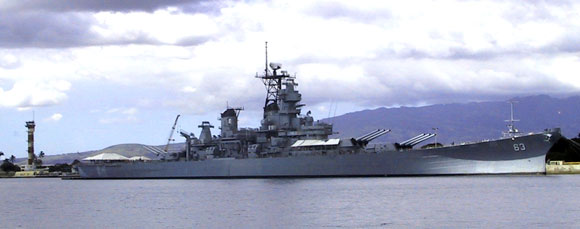
USS Missouri Memorial Association, Inc.
Pier Foxtrot-5, Pearl Harbor
63 Cowpens St.
Honolulu, HI 96818
808-423-BB63 (808-423-2263)
Fax: 808-423-0700
http://www.ussmissouri.org
USS Utah (BB-31, then AG-16)
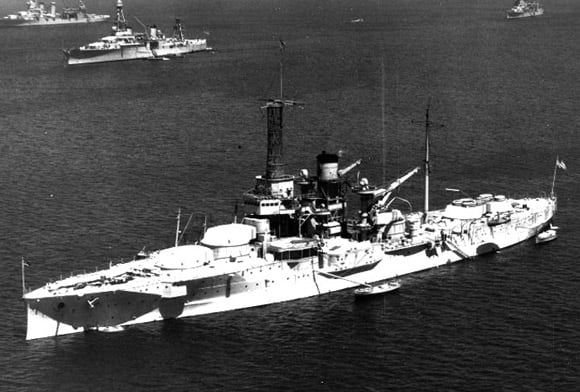
World War II Valor in the Pacific National Monument
National Park Service
1 Arizona Memorial Place
Honolulu, HI 96818-3145
(808) 422-2771
Recorded Message (808) 422-0561
Fax: (808) 483-8608
http://www.nps.gov/valr/index.htm
http://www.pacifichistoricparks.org/
From Naval History Magazine, Aug. 2001:
The Arizona (BB-39) Memorial is the most-visited World War II site in the Pacific. On the opposite side of Pearl Harbor’s Ford Island, however, is a little-known memorial to another ship, also lost on 7 December 1941, that should not be forgotten.
Just more than 30 years old, the USS Utah (AG-16) had served the Navy well in two roles: as a battleship, working as a convoy escort off the British Isles during World War I; and as a target and training ship that could be piloted by remote control. Among her recent duties, she served as a target ship for naval aviators and as an antiaircraft gunnery training ship. On the morning of 7 December 1941 she was moored on the west side of Ford Island at berth F-11, Pearl Harbor, Hawaii.
Illinois
German U-505
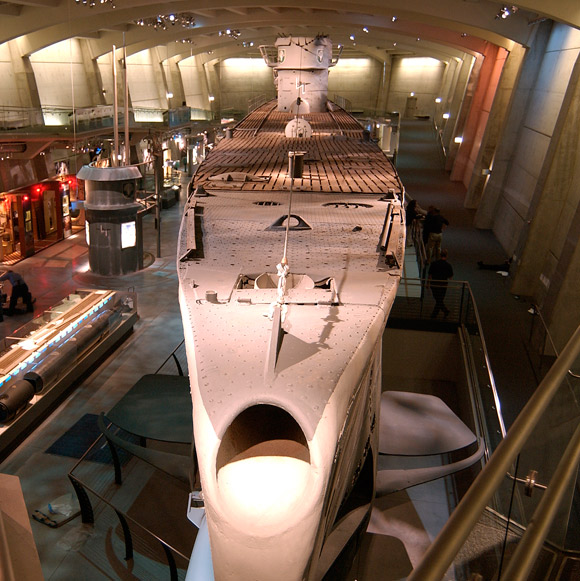
Museum of Science & Industry
5700 Lake Shore Drive
Chicago, Illinois 60637-2093
(773) 684-1414
Fax: (773) 684-5580
http://www.msichicago.org/whats-here/exhibits/u-505/
From Proceedings, March 1960:
Since 1954 the steps of some two million visitors have clanged on the deck, ladders, and passageways of a 250-foot monster “moored” at Chicago’s Museum of Science and Industry. This is the German submarine, U-505, captured in a running battle off the Cape Verde Islands in June 1944 by USS Guadalcanal’s hunter-killer group. The story of her capture is well known. But that was the ending — the terminus of the life of this U-Boat in the service of the German Kriegsmarine.
Indiana
USS LST-325
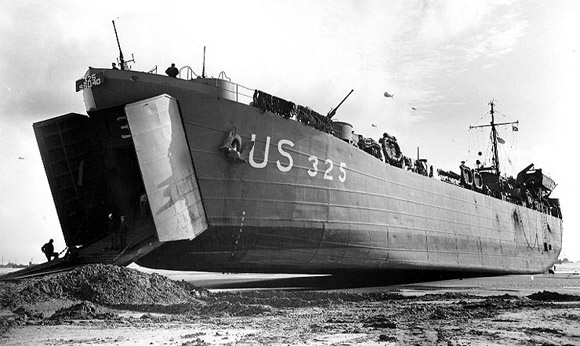
USS LST Ship Memorial, Inc.
840 LST Drive
Evansville, IN 47713
(812) 435-8678
Email: [email protected]
http://www.lstmemorial.org
Louisiana
USS Kidd (DD-661)
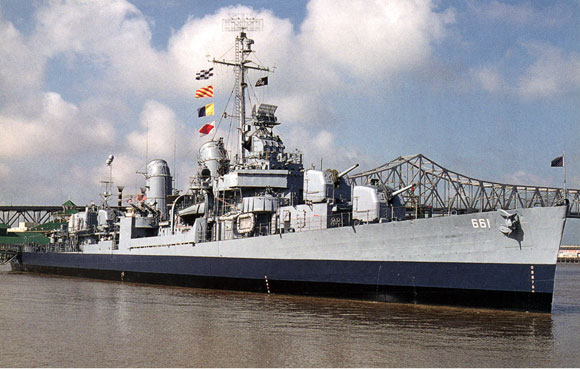
USS Kidd Veterans Memorial
305 South River Road
Baton Rouge, LA 70802
(225) 342-1942
Fax: (225) 342-2039
Email: [email protected]
http://www.usskidd.com
USS Orleck (DD-886)
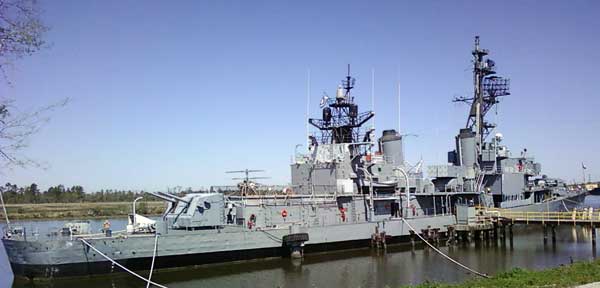
USS Orleck Naval Memorial Inc.
604 North Enterprise Blvd.
Lake Charles, LA 70601-2339
(337) 433-4083
Email: [email protected]
http://www.orleck.org
Maryland
Lightship Chesapeake (LV-116, WAL538)
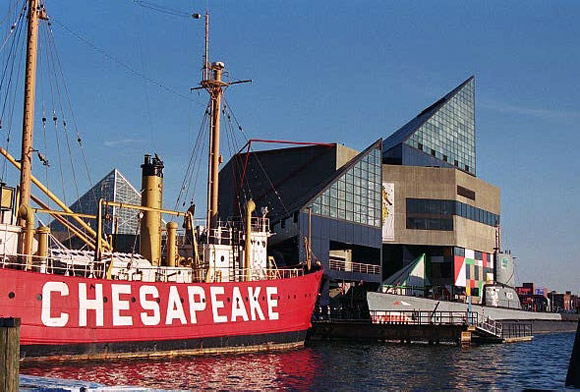
Historic Ships of Baltimore
802 S. Caroline St.
Baltimore, Maryland 21231
(410) 396-3453
Fax (410) 396-3393
Email: [email protected]
http://www.historicships.org/
http://www.usstorsk.org
USS Constellation
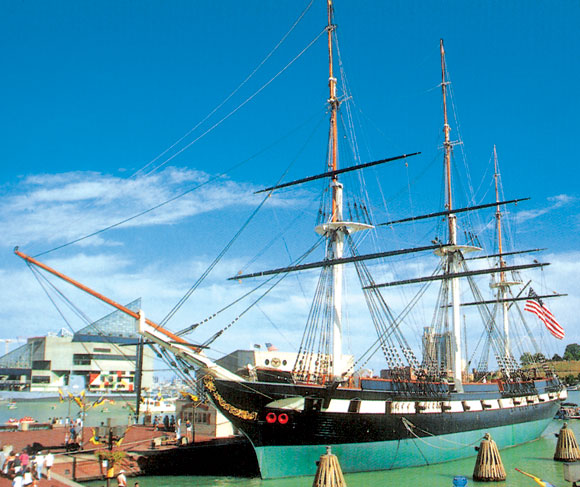
U.S.S. Constellation Museum
Pier 1, 301 East Pratt Street
Baltimore, Maryland 21202-3134
(410) 539-1797
Fax: (410) 539-6238
Email: administration@http://www.historicships.org
http://www.historicships.org/
SS John W. Brown
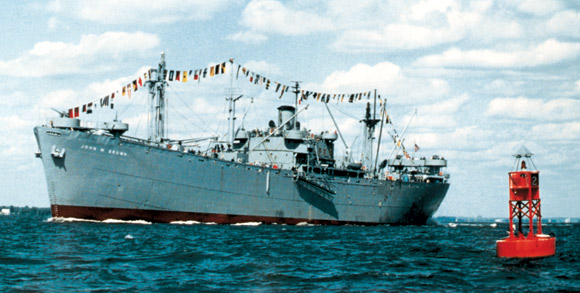
Project Liberty Ship, Inc.
Box 25846
Highlandtown Station
Baltimore, Maryland 21224-0564
(410) 558-0646
Fax: (410) 558-1737
Email: [email protected]
Email (for overnight encampments): [email protected]
http://www.liberty-ship.com
USCGC Taney (WHEC-37)
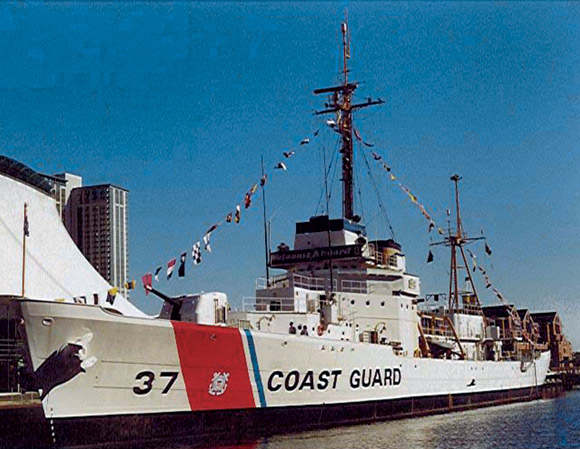
Historic Ships of Baltimore Maritime Museum
802 S. Caroline St.
Baltimore, Maryland 21231
(410) 396-3453
Fax (410) 396-3393
Email: [email protected]
http://www.historicships.org/
http://www.usstorsk.org
From Naval History Magazine, Winter 1988:
From southern France to Corregidor to Okinawa to the final landings in Borneo, the Secretary-class AGCs participated in 14 invasion assaults. Some met only light opposition, but the Taney was under fire for 14 weeks at Okinawa, and in one six-week period went to general quarters 119 times.
After World War II the 327s returned to Coast Guard control and were converted to ocean station vessels (OSVs). In 1946, all were assigned to ocean station duty. This was to be their primary role for the next two decades. Though they supplied essential weather and navigation information for the rapidly expanding international aviation routes, the long, rough patrols were tedious for most Coast Guardsmen. But there were moments of high drama. Among her 327-foot peers, the Bibb was the undisputed rescue champ, saving more than 400 lives in just six years. In 1947 she rescued all 69 people from the Bermuda Sky Queen seaplane when it ditched in the sea midway between Newfoundland and Ireland. The following year, the Bibb rescued 48 persons from the schooner Gaspar after driving to the distressed vessel through 40-foot seas.
The year before her 1986 decommissioning, the Taney-by then the Ingham’s sole surviving sister-captured a drug vessel 800 miles off the Florida coast with a cargo of drugs valued at $140 million, an all-time record seizure.
USS Torsk (SS-423)
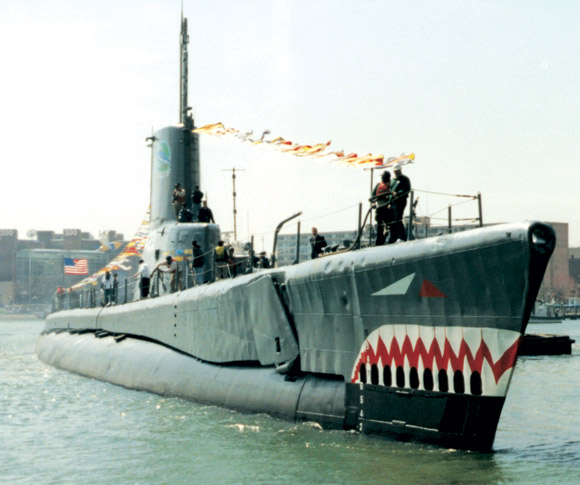
Historic Ships of Baltimore Maritime Museum
802 S. Caroline St.
Baltimore, Maryland 21231
(410) 396-3453
Fax: (410) 396-3393
Email: [email protected]
http://www.historicships.org/
http://www.usstorsk.org
From Naval History Magazine, Summer 1993:
The Baltimore Maritime Museum, recently transferred from the city of Baltimore to a private, nonprofit corporation, boasts among its holdings the submarine Torsk (SS-423), the lightship Chesapeake, and the Coast Guard cutter Taney (WHEC-37). Presently, the museum’s headquarters is based on board the Taney, while several of its detailed ship models are on display four blocks away in the Baltimore Convention Center.
Because World War II submarines were appropriately named after fish, the Torsk is named after a species similar to North Atlantic codfish. A Trench-class submarine, the Torsk represents the level U.S. submarine development reached during the war. Because she was commissioned late in the war (December 1944), few targets were left, largely because of the success of her sister submarines. The Torsk does, however, have the distinction of sinking the last Japanese combatants in World War II, when she torpedoed Coast Defense Vessels #13 and #47 on 14 August 1945.
After conversion to a snorkel-equipped Guppy submarine in 1951, the Torsk participated in peacetime deployments in the Mediterranean and the Atlantic, including an inland cruise to the Great Lakes, celebrating the opening of the St. Lawrence Seaway in 1959. She was also involved in the Lebanon Crisis in 1960, as well as the Cuban Missile Blockade, during which her crew boarded Soviet ships for inspection
Massachusetts
USS Cassin Young (DD-793)
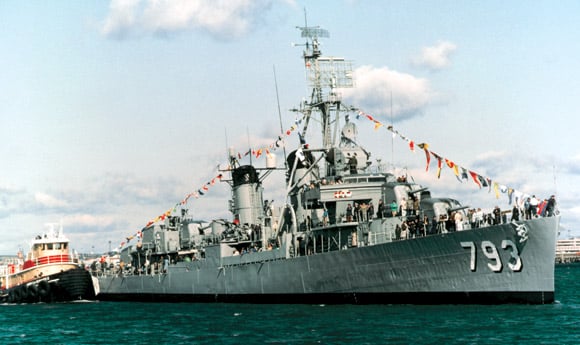
Boston National Historical Park
Charlestown Navy Yard
Boston, Massachusetts 02129-4543
(617) 242-5601
Fax: (617)-241-0884
http://www.nps.gov/bost/historyculture/usscassinyoung.htm
USS Constitution
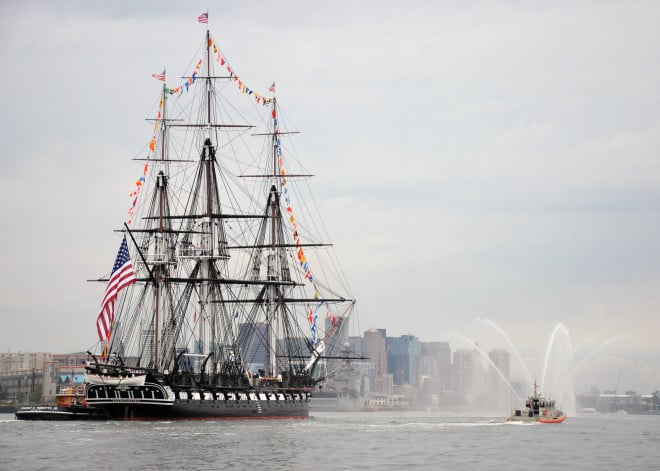
USS Constitution
Charlestown Navy Yard
Boston, Massachusetts 02129-1797
(617) 242-5671
Fax: (617) 242-5616
http://www.history.navy.mil/ussconstitution/index.html
Gimik Semi Submersible
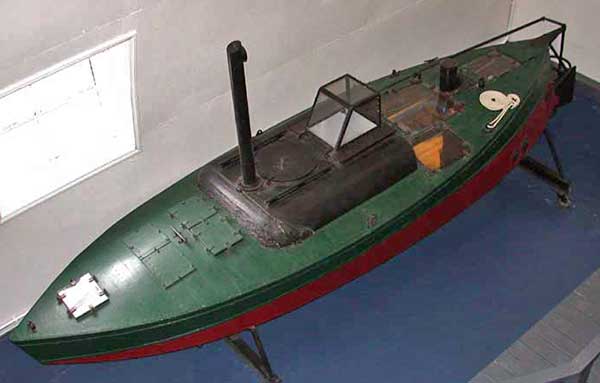
Battleship Cove
5 Water Street, P.O. Box 111
Fall River, MA 02722-0111
(508) 678-1100
Fax: (508) 674-5597
Email: [email protected]
http://www.battleshipcove.org
Hiddensee
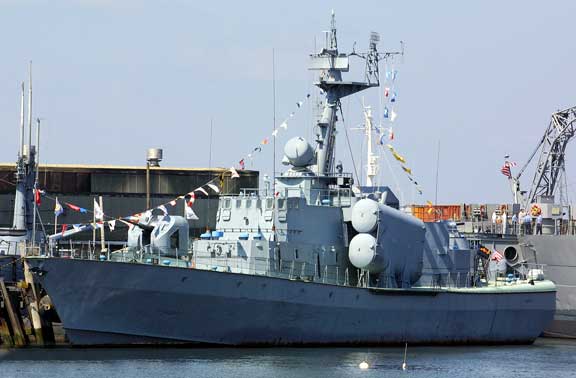
Battleship Cove
5 Water Street, P.O. Box 111
Fall River, MA 02722-0111
(508) 678-1100
Fax: (508) 674-5597
Email: [email protected]
http://www.battleshipcove.org
USS Joseph P. Kennedy, Jr. (DD-850)

Battleship Cove
5 Water Street, P.O. Box 111
Fall River, MA 02722-0111
(508) 678-1100
Fax: (508) 674-5597
Email: [email protected]
http://www.battleshipcove.org
LCM 56
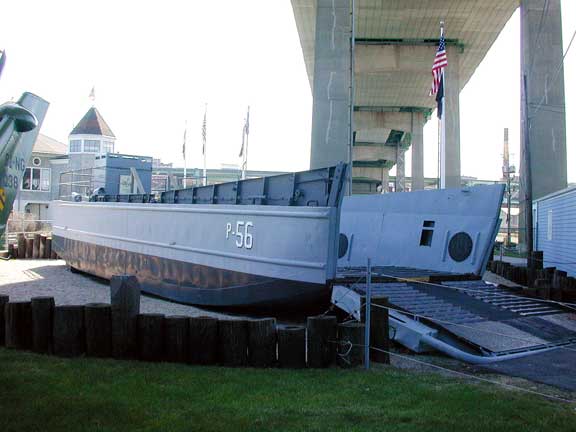
Battleship Cove
5 Water Street, P.O. Box 111
Fall River, MA 02722-0111
(508) 678-1100
Fax: (508) 674-5597
Email: [email protected]
http://www.battleshipcove.org
USS Lionfish (SS-298)
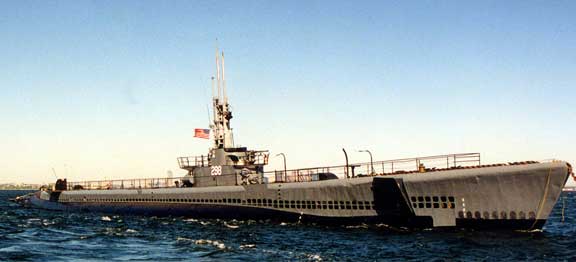
Battleship Cove
5 Water Street, P.O. Box 111
Fall River, MA 02722-0111
(508) 678-1100
Fax: (508) 674-5597
Email: [email protected]
http://www.battleshipcove.org
Tug Luna
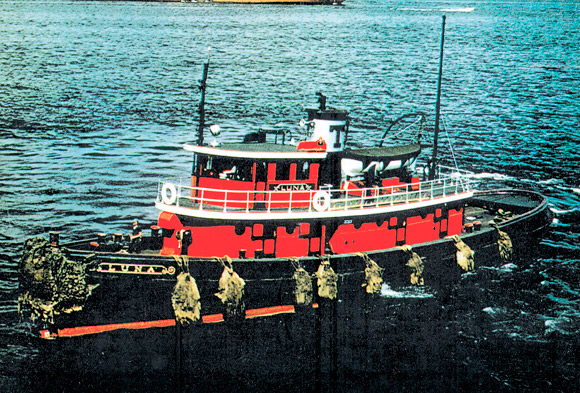
Luna Preservation Society
P.O. Box 1866
Brookline, MA 02446
Email: [email protected]
http://www.tugboatluna.org
USS Massachusetts (BB-59)
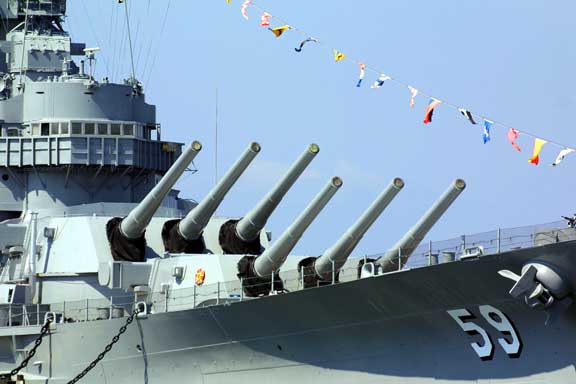
Battleship Cove
5 Water Street, P.O. Box 111
Fall River, MA 02722-0111
(508) 678-1100
Fax: (508) 674-5597
Email: [email protected]
http://www.battleshipcove.org
Lightship Nantucket (LV-112, then WAL-534)
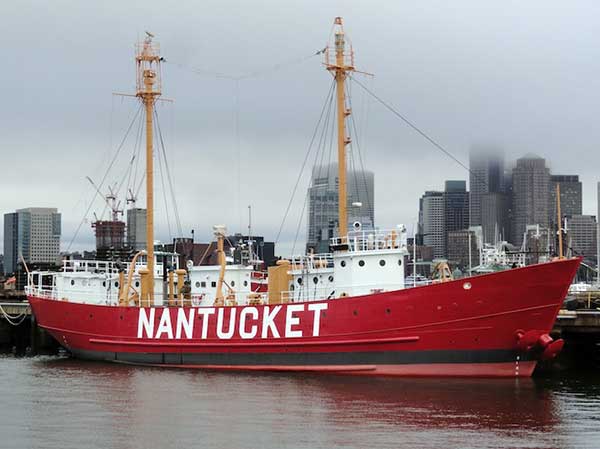
United States Lightship Museum
(617) 797-0135
Fax: (603) 394-0285
Boston Harbor Shipyard and Marina
256 Marginal Street
East Boston, MA 02128
http://www.nantucketlightshiplv-112.org/
From Naval History Magazine, Winter 1990:
The most dangerous duty in the Coast Guard, the lightship, ended in the year 1983. These jaunty, high-sided vessels were part of the maritime scene as far back as 1820, and their necessarily exposed locations-along with the requirement that they remain on station regardless of winds and seas-resulted in numerous disasters and accidents. Natural causes swept lightships off their stations some 230 times. There were 150 documented collisions with other vessels, ranging from barges to the liner Olympic in 1934. The latter instance was one of the five lightships sunk by collision.
The victim in the above collision was the Nantucket lightship, a vessel seemingly “jinxed” by fate (as well as her far offshore location). From 1854 to 1934 the vessels on this station were washed ashore (1854), broken from their moorings (1856, 1892, 1895, and 1896), and sunk (1905 and 1934). Another unexpected turn of events was the sinking of Diamond ShoalsLightship by a World War I U-boat.
Despite improving technology-diesel power, watertight integrity, better fog signals, etc.-the replacement of these dangerous vessels by automated radio-controlled units was welcomed by the service. From a peak of 56 ships in 1909, the number declined steadily until 1983 with the retirement of theNantucket Shoals vessel. Sixteen of these ships remain accessible to the public, 14 as museums and two as floating restaurants.
PT-617
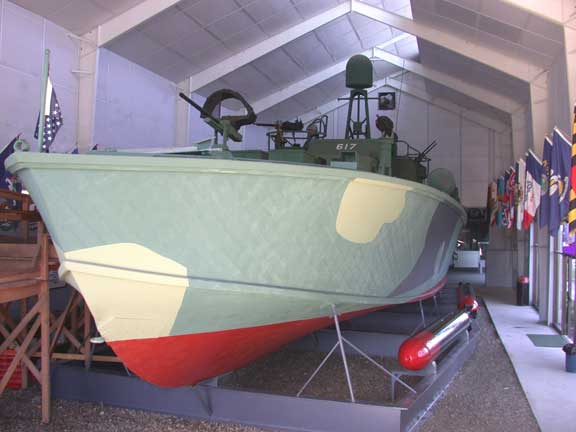
Battleship Cove
5 Water Street, P.O. Box 111
Fall River, MA 02722-0111
(508) 678-1100
Fax: (508) 674-5597
Email: [email protected]
http://www.battleshipcove.org
From Naval History Magazine, Feb. 2011:
Located on Mount Hope Bay in Fall River, Massachusetts, Battleship Cove is home to the national historic landmarks USSMassachusetts , Joseph P. Kennedy Jr. , Lionfish , PT 617 , and PT 796 . The patrol boats, covered in Naval History ’s April 2001 “Museum Report” and displayed at the National PT Boat Museum, are the world’s only restored pair of motor torpedo boats. The museum also exhibits squadron plaques, scale models of PT boats, a captured Japanese suicide demolition boat, and the actual model of the PT boat used in the 1965 movie In Harm’s Way , starring John Wayne. A wall plaque honors PT boaters killed in action, and a video presents oral descriptions of the boats’ contributions in World War II.
PT-796
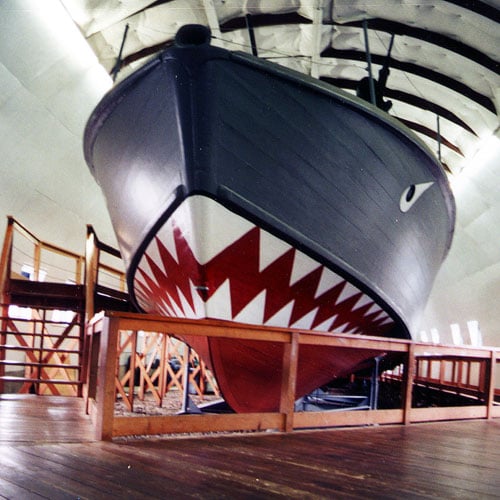
Battleship Cove
5 Water Street, P.O. Box 111
Fall River, MA 02722-0111
(508) 678-1100
Fax: (508) 674-5597
Email: [email protected]
http://www.battleshipcove.org
From Naval History Magazine, Feb. 2011:
Located on Mount Hope Bay in Fall River, Massachusetts, Battleship Cove is home to the national historic landmarks USSMassachusetts , Joseph P. Kennedy Jr. , Lionfish , PT 617 , and PT 796 . The patrol boats, covered in Naval History ’s April 2001 “Museum Report” and displayed at the National PT Boat Museum, are the world’s only restored pair of motor torpedo boats. The museum also exhibits squadron plaques, scale models of PT boats, a captured Japanese suicide demolition boat, and the actual model of the PT boat used in the 1965 movie In Harm’s Way , starring John Wayne. A wall plaque honors PT boaters killed in action, and a video presents oral descriptions of the boats’ contributions in World War II.
Continuing on a self-guided tour, visitors can inspect a U.S. Army Cobra AH-1S attack helicopter, an Army Bell UH-1 “Huey” helicopter, and a Navy T28 Trojan Trainer aircraft. But Battleship Cove’s anchor is the Massachusetts , “Big Mamie” to her crew. She houses the official state of Massachusetts memorial to Bay Staters killed in World War II and the Persian Gulf War. In 1942 Big Mamie fired 16-inch shells against the Vichy French battleship Jean Bart at Casablanca, sinking her. In all the Massachusettssteamed 225,000 nautical miles, earning 11 battle stars in 35 major campaigns, from North Africa in 1942 to Iwo Jima in 1945. She was decommissioned 27 March 1947.
USS Salem (CA-139)
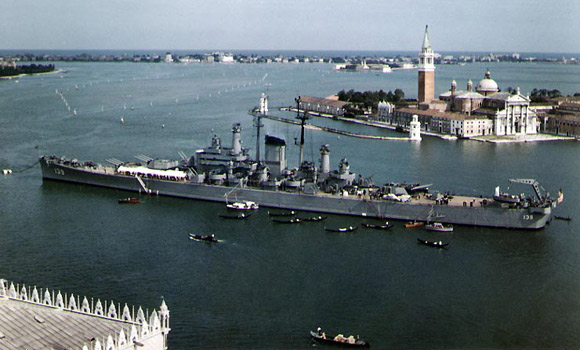
United States Naval Shipbuilding Museum
Massachusetts Military Research Center
739 Washington Street
Quincy, Massachusetts 02169
(617) 479-7900
Fax: (617) 479-8792
Email: [email protected]
Email (for overnight encampments): [email protected]
http://www.uss-salem.org
From Naval History Magazine, Jan./Feb. 1995:
The USS Salem (CA-139) is home again at last, after a process that lasted more than two years. One of the world’s few surviving heavy cruisers has completed the last leg of her final voyage, from her reserve fleet berth at the Philadelphia Navy Yard to the site of the old Fore River Shipyard, Quincy, Massachusetts, where she was built more than 40 years ago. The Salem will become the centerpiece of the new U.S. Naval Shipyard Museum scheduled to open in the fall of 1995.
The Salem has been docked at Philadelphia since being decommissioned in 1959. One of only three Des Moines (CA-134)-class heavy cruisers, she served with distinction during the first ten years of the Cold War. The 716-foot warship with a displacement of 17,000 tons had a main battery of nine 8-inch guns triple-mounted in three turrets. The Salem served eight years as flagship of the Sixth Fleet in the Mediterranean, and in 1953, she was the first ship to arrive at the earthquake-devastated Greek Ionian Islands, where her rescue work earned international acclaim for the ship and her crew. In 1955, she became the first U.S. warship to visit Yugoslavia since World War II.
The U.S. Shipbuilding Museum at Quincy comprises ten acres of the former Bethlehem shipbuilding facilities. At its peak production during the two World Wars, Bethlehem employed more than 80,000 workers and was the life center for its surrounding communities. The yard’s origins date back to 1884, when Thomas A. Watson-known best as the person to receive the first telephone call from Alexander Graham Bell-opened the Fore River Engine Company. The business got its first Navy contract in 1896 for two, 400-ton torpedo boat destroyers. Bethlehem Steel Corporation acquired the yard just prior to World War I and sold it to General Dynamics in 1963.
German Seehund (KU-5075)
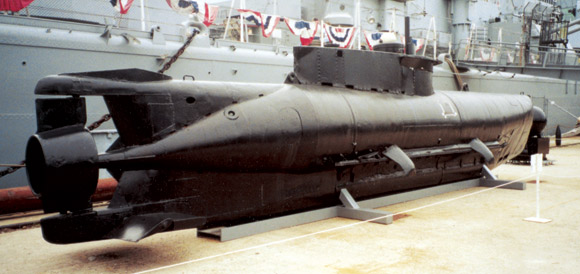
United States Naval Shipbuilding Museum
Massachusetts Military Research Center
739 Washington Street
Quincy, Massachusetts 02169
(617) 479-7900
Fax: (617) 479-8792
Email: [email protected]
Email (for overnight encampments): [email protected]
http://www.uss-salem.org
From the Historic Naval Ships Association:
The Seehund (seal) was the most successful of several Nazi attempts to perfect a midget submarine. Operated by two men and carrying two underslung torpedoes, the Seehund was used very effectively in the waning months of World War II, sinking over 120,000 tons of allied shipping. Their small size and rapid evasive action made them virtually undetectable and depth charges seemed to bounce off of their resilient hulls. In the final months of the war, the Seehunds were used as “butter boats” to replenish the dwindling supplies of German garrisons stranded along the coast.
Michigan
SS City of Milwaukee
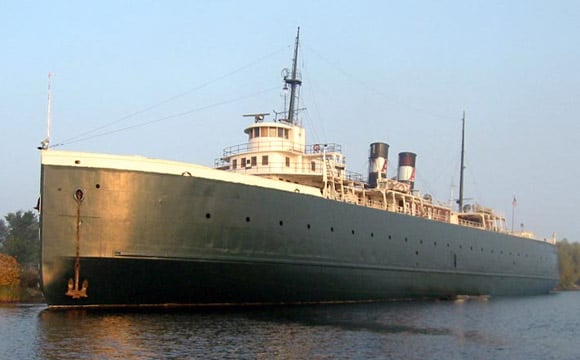
SS City of Milwaukee National Historic Landmark
99 Arthur Street (US-31 North)
Manistee, MI 49660
(231) 723-3587
http://carferry.com/
From the Historic Naval Ships Association:
The National Historic Landmark vessel S.S. City of Milwaukee is the last surviving traditional Great Lakes railroad car ferry. These unique and sturdy vessels navigated the frozen and storm-tossed inland seas carrying passengers and entire freight trains for a century. The ship features two triple expansion steam engines and four scotch fire tube boilers. The sturdy ice breaking riveted steel hull is complimented by varnished oak and brass interiors done in the craftsman style.
During World War II the ship ferried war materials across Lake Michigan and provided training for Coast Guard and Navy officers. The ship is open to the public for guided tours, special events and private party rentals.
SS City of Milwaukee is on the National Register of Historic Places and is a National Historic Landmark.
USS Edson (DD-946)
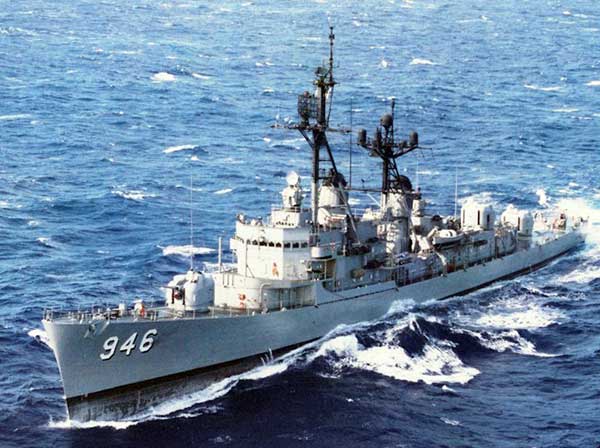
Saginaw Valley Naval Ship Museum
1680 Martin Street
Bay City, MI 48706
1-989-684-3946
Fax: 1-989-684-3947
http://www.ussedson.org
From the Historic Naval Ships Association:
USS Edson was the last of the 18 Forrest Shermans to be retired. As the first post WW II destroyer design, theSherman class reflected the combat lessons learned during that conflict as well as in Korea.
Initially assigned to the Pacific Fleet, Edson participated in numerous combat missions off Vietnam. She received three Navy Unit Commendations for this service. She received Meritorious Unit Commendations for her participation in the evacuations of Phnom Penh, Cambodia, and Saigon, Vietnam. Later she was transferred to the Atlantic where she served as flagship of Surface Group Four in Newport.
Decommissioned in December 1988, she was quickly transferred to the Intrepid Museum. She was returned to the Navy in 2004, and was donated to Saginaw Valley Naval Ship Museum in 2012.
USS Edson is a National Historic Landmark.
USS LST-393
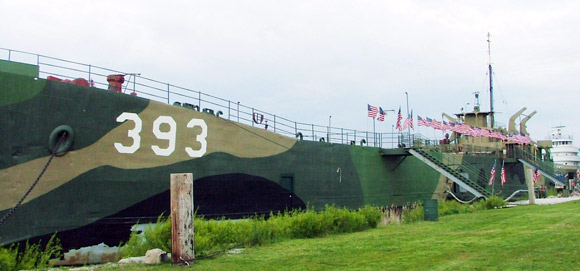
USS LST-393
560 Mart Street
Muskegon, MI 49440-1044
(231) 730-1477
Fax: (231) 722-0016
Email: [email protected]
http://www.lst393.org/
From the Historic Naval Ships Association:
USS LST-393 participated in three major invasions in the European Theater in World War II. She was awarded battle stars for the Sicilian occupation, the Salerno landings and the Normandy campaign. Her actions off the coast of France included participation in the bombardment of Cherbourg on 25 June 1944. In addition to transporting thousands of vehicles and troops during these landings, she also ferried casualties to safety and prisoners of war to detention locations. In carrying out these missions, she touched anchor in more than 30 ports in the European-African Theater.
After completing her duty in the European theater, LST-393 was sent back to Norfolk, Virginia where she was painted in a camouflage scheme, as was typical for ships landing on the beaches in the Pacific Theater. The war in the Pacific ended, however, before she landed on a hostile beach in that theater.
LST-393 was decommissioned in New Orleans, Louisiana in 1946, painted black, and sold to the Wisconsin and Michigan Steamship Company of Milwaukee. She operated as a transport ferry for automobiles on Lake Michigan under the name of Highway 16 until 1973. Since then LST-393 sat unused and un-attended.
Starting in 2005, under the care of the USS LST 393 Preservation Association, a serious and very vigorous program of restoration and preservation has been ongoing.
USCGC Mackinaw (WAGB-83)
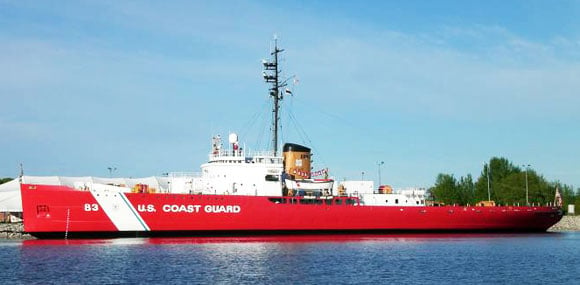
Icebreaker Mackinaw Maritime Museum
131 South Huron Street
Post Office Box 39
Mackinaw City, MI 49701-0039
(231) 436-9825
Fax: (231) 436-9826
Email: [email protected]
http://www.themackinaw.org/
From the Historic Naval Ships Association:
The Icebreaker Mackinaw (WAGB-83) was constructed during World War II to facilitate winter shipping to maintain year-round war-time production of steel. Normally the lake ice thaws at the end of April, but Mackinawopened and maintained Great Lakes shipping lanes as early as the third week in March, thus facilitating the early shipping of millions of tons of iron ore and other materials. Usually during the first week in March the Mackinawwould head for the strategic area of the Straits of Mackinac to begin ice operations. As conditions would permit she would work up through the St. Mary’s River to the Soo Locks, into Whitefish Bay and Lake Superior. Later the icebreaker would work in the lower lakes areas.
She is a variant of the Wind class polar icebreakers. Her design is made longer with a wider beam and shallower draft to allow her to operate in the Great Lakes. Mackinaw was built to be literally land-locked, her size not permitting her to leave the Great Lakes.
A diesel electric power plant delivers 10,000 h.p. through twin screws in the stern and one in the bow. The bow propeller is employed to suck the water beneath the ice allowing the Maierform bow to break the ice. When theMackinaw drives its great bow onto the ice, the icebreaker is capable of breaking through 4 feet of solid sheet ‘blue’ ice. Mackinaw has also plowed through 37 ft. of ‘windrow’ (broken) ice.
Early in its life Mackinaw was used to handle the heaviest buoys on the lakes with the aid of its two 12-ton cranes, to carry fuel and supplies to light stations, to serve as a training ship, and to assist vessels in distress when necessary. In recent decades she continued to extend the shipping season from late March until mid-January. She also served as a goodwill ambassador for the Coast Guard and a training vessel.
The “Mac”, “Queen of the Great Lakes” as Mackinaw has been known with affection, provided 62 years of outstanding service facilitating commerce in support of the economy of the entire nation. She now resides in Mackinaw City, the community for which she was named.
USCGC McLane (WMEC-146)
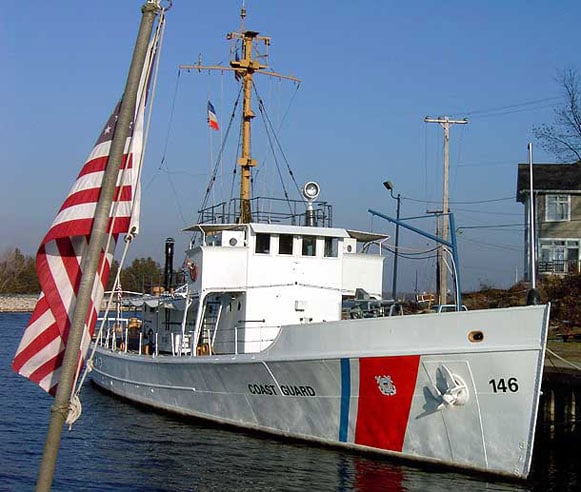
Great Lakes Naval Memorial and Museum
1346 Bluff Street
Muskegon, Michigan 49441
(231) 755-1230
Fax: (231) 755-5883
Email: [email protected]
http://www.silversidesmuseum.org/
From the Historic Naval Ships Association:
USCGC McLane was authorized during Calvin Coolidge’s administration as one of a class of 1933 “Rum Chasers” for use during prohibition. She and her sisters were the last military vessels built for the U.S. Government that carried an auxiliary sail rig. Until the onset of World War II, McLane was based at a number of west coast stations.
Her World War II duties took McLane to Ketchikan, Alaska where she was manned by a Coast Guard crew, but under Navy operational control. On July 9, 1942, working with a Coast Guard manned Navy patrol craft, she established sonar contact with a Japanese submarine known to be in the area. After a day long chase during which she dropped numerous depth charges, a large oil slick appeared on the surface, and no further contact with the sub was to be had. Sources indicate the Japanese submarine RO-32 was lost in the area at this time, and McLane is generally credited with the sinking.
Following the war, McLane resumed her law enforcement and search and rescue duties, operating out of Sitka, Alaska; Aberdeen, Washington; and finally Brownsville, Texas. She was decommissioned in 1969, and acquired by a Sea Scout group in Chicago. She was acquired by the USS Silversides and Maritime Museum in 1993.
SS Milwaukee Clipper
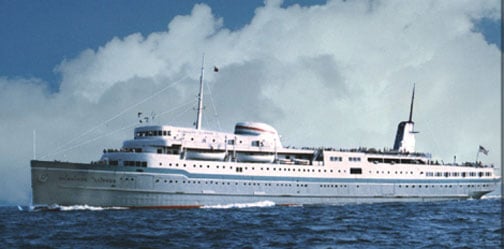
SS Milwaukee Clipper Preservation, Inc.
P.O. Box 1370
Muskegon, MI 49443-1370
(231) 755-0990
Fax: (231) 722-3533
Email: [email protected]
From the Historic Naval Ships Association:
The oldest American passenger steamship on the Great Lakes, the Milwaukee Clipper was built as the Juniata to carry passengers and freight. Her quadruple-expansion steam engine is one of the few surviving examples of this important engine type. In 1940 she was rebuilt as the Clipper. The entire ship reflected the new aesthetic streamlining of the Art Moderne style. Many design elements introduced in the Clipper are still being included in modern ocean-going passenger ships. The rebuilt ship served the route between Milwaukee, Wisconsin and Muskegon, Michigan from 1941 to 1970.
During World War II the Clipper transported defense materials from Muskegon to Milwaukee. In peacetime, her only cargo was automobiles. Contracts with auto manufacturers to transport new cars during the winter months allowed the ship to operate at a profit without a full passenger load after most all-passenger vessels were forced into retirement.
Following extensive restoration efforts, the ship was opened for tours in August 2000. Visitors can now tour the pilothouse, some staterooms, crew quarters, dance floor and movie theater. There are also displays of memorabilia from both the Juniata and the Clipper. They include photographs, brochures, dishes and other items of interest. She is closed for the winter months. Restoration work will continue for the foreseeable future.
USS Silversides (SS-236)
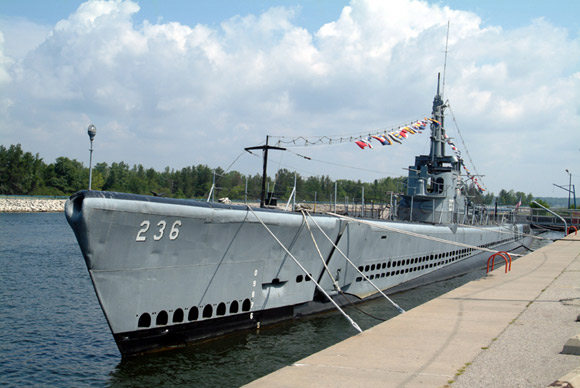
Great Lakes Naval Memorial and Museum
1346 Bluff Street
Muskegon, Michigan 49441
(231) 755-1230
Fax: (231) 755-5883
Email: [email protected]
http://www.silversidesmuseum.org/
From Naval History Magazine, Spring 1993:
The Silversides, the nation’s most famous surviving submarine of World War II, is perhaps the best preserved and restored member of the Gato (SS-212) class on display today. Virtually unmodified since last refitted at Pearl Harbor in May 1945, the submarine is part of a fledgling museum in Pere Marquette Park along the Muskegon Lake Channel. Today, the venerable raider offers a view of a working ship that appears as if the crew just went ashore for coffee-allowing her guests a glimpse of her illustrious past.
Few of the 250 or so submarines that prowled the far reaches of the war-torn Pacific were able to equal theSilversides‘s record. John D. Alden’s recent work, U.S. Submarine Attacks of World War 11, credits the Silversideswith sinking 31 ships totaling 100,685 tons-possibly leading all U.S. Navy submarines-and damaging another nine ships for 27,187 tons. She was originally credited by the Joint Army Navy Assessment Committee with sinking 23 ships totaling 90,080 tons, ranking her third in number of ships sunk and fifth in tonnage destroyed.
Commissioned 15 December 1941, eight days after the attack on Pearl Harbor, the Silversides completed 14 war patrols between 30 April 1942 and 30 July 1945 and was decorated with four Presidential Unit Citations, 12 Battle Stars, the American Campaign Medal, the World War II Victory Medal, and the Asiatic-Pacific Campaign Medal with 2 Silver Stars and 2 Bronze Stars. Her second and only surviving skipper, retired Rear Admiral John S. Coye, Jr., of Coronado, California, ranked tenth among U.S. submarine skippers for his leadership during patrols 6 through 11. Other submarine force legends serving on board the Silversides include Creed C. Burlingame, Roy M. Davenport, Frank G. Selby, and Cyrus C. Cole.
Mississippi
USS Cairo
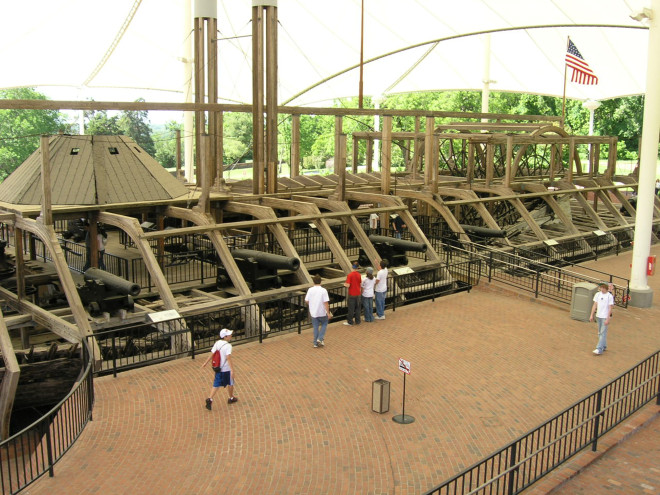
Vicksburg National Military Park
3201 Clay Street
Vicksburg, MS 39180-3495
(601) 636-2199
Fax: (610) 638-7329
Email: [email protected]
http://www.nps.gov/vick/index.htm
From Naval History Magazine, Oct. 2008
Faber-Castell, Lea & Perrins, E. R. Squibb, and Goodyear Rubber. What do these companies have in common? In existence since at least the Civil War era, each manufactured items recovered from the Union ironclad gunboat USS Cairo , which was raised from the muddy bottom of the Yazoo River in 1964. More than a century earlier, on 12 December 1862, the ship had sunk only 12 minutes after Confederates ashore electrically detonated two torpedoes alongside her.
Although the Cairo ‘s war record was disappointing for the Union, what she took with her when she went down has proved a boon to historians. Because she sank so quickly, crewmen were unable to save most of their belongings. The personal artifacts subsequently recovered—items such as pencils, bottles of Worcestershire sauce, medicine bottles, combs, and buttons—provide glimpses into the everyday life of the Civil War Sailor.
A normal day for the Cairo ‘s 175 officers and crewmen began at 0530, when they were awakened. For the crew it included scrubbing and swabbing the decks, drilling on the guns, and preparing for and being inspected. The Sailors were responsible for maintaining their uniforms, which included washing and mending them. For the latter, they had sewing kits, called “housewives”—usually small tin canisters containing pins, needles, linen thread, spare buttons, and thimbles. As well as housewives, scissors of all sizes were recovered from the Cairo .
Conservators found several different types of buttons on board, including black, hard-rubber U.S. Navy enlisted pea-coat buttons manufactured by the Novelty Rubber Company of New York. The most prevalent buttons discovered, however, were durable, three-piece brass military shell buttons made by the Scovill Manufacturing Company in Waterbury, Connecticut.
Missouri
USS Aries (PHM-5)
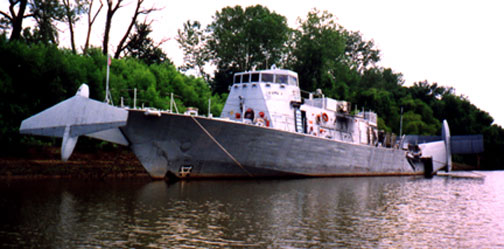
USS Aries Hydrofoil Memorial
Mr. Eliot James, President
1375 Private Road 1188
Callao, MO 63534-3800
(660) 269-9200
Fax: (660) 269-9205
Email: [email protected]
http://www.ussaries.org
From the Historic Naval Ships Association:
USS Aries was home-ported in Key West for most of her 11 years of service. She conducted law enforcement operations against smugglers in cooperation with the Coast Guard in the Gulf of Mexico and the east coast of Central America. She took part in various fleet exercises including the “Ocean Venture” and “Solid Shield” series. She also participated in a number of UNITAS exercises with Central and South American Navies. She and the other five ships of the class were decommissioned in 1993 with the downsizing of the U.S. Navy fleet.
Aries is now located on the Grand River Waterfront in Brunswick, Missouri. Restoration efforts are ongoing. She opened for public tours in October 2002.
Nebraska
USS Hazard (AM-240)
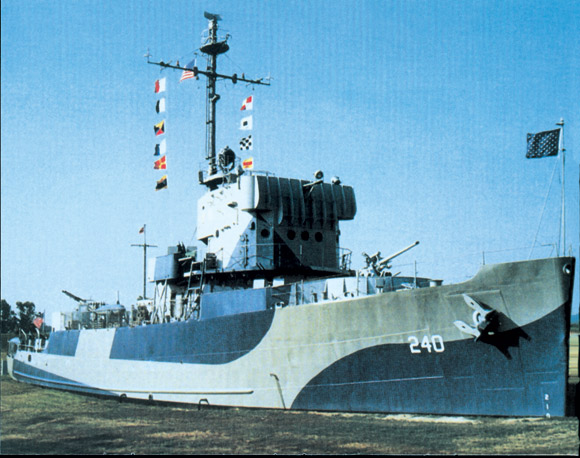
Freedom Park
2497 Freedom Park Road
Omaha, Nebraska 68110-2745
(402) 444-5900
Fax: (402) 444-5955
Email: [email protected]
http://www.cityofomaha.org/parks/parks/specialty-parks/freedom-park
From the Historic Naval Ships Association:
The only surviving Admirable class minesweeper, the largest and most successful American minesweepers, Hazardwas fitted for both wire and acoustic sweeping and could double as an antisubmarine warfare platform. TheAdmirable class vessels were also used for patrol and escort duties. Hazard first served in this capacity, escorting a convoy from San Francisco to Pearl Harbor, and then running with convoys to Eniwetok and Ulithi. In March 1945, the sweeper was sent to Okinawa, where she first performed antisubmarine patrols before sweeping the waters off Kerama Retto in keeping with the minesweeper’s slogan, “No Sweep, No Invasion.”
At the war’s end the ship cleared the seas off Korea and Japan for the occupation forces. Returning to the United States in 1946, Hazard was decommissioned and joined the reserve fleet.
USS Marlin (SST-2)
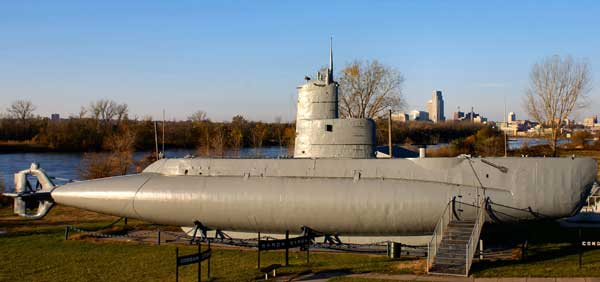
Freedom Park
2497 Freedom Park Road
Omaha, Nebraska 68110-2745
(402) 444-5900
Fax: (402) 444-5955
Email: [email protected]
http://www.cityofomaha.org/parks/parks/specialty-parks/freedom-park
From the Historic Naval Ships Association:
Homeported in Key West, Florida for her entire commissioned service lifetime, USS Marlin provided target and training ship services and helped to evaluate submarine and anti-submarine equipment and tactics. In 1955, she participated in mine warfare maneuvers with a task force under Commander, Mine Force. From 1956 to 1963, she deployed regularly to Guantanamo Bay, Cuba where she provided services to the Fleet Training Group.
Marlin remained in her home waters off Key West from 1963 until her decommissioning in 1973. During this period she performed target duty for Atlantic Fleet surface and air anti-submarine units.
New Hampshire
USS Albacore (AGS-569)

Albacore Park
600 Market Street
Portsmouth, New Hampshire 03801
(603) 436-3680
Fax (603) 436-3680
Email: [email protected]
http://www.ussalbacore.org
From Naval History Magazine, Oct. 2003:
We pulled off 1-95 and saw a submarine sitting in a field, the former USS Albacore (AGSS-569). She was not a warship; indeed, she was not equipped with torpedo tubes or torpedoes. But her active career from the 1950s to the 1970s was instrumental in the design of the combatant submarines that followed. She was the pioneer that tested the teardrop hull that benefits from the same hydrodynamic qualities that a whale uses in making its way through the water. With the advent of nuclear power, submarines were no longer submersible surface ships. They became ships that could spend much of their time underwater and thus needed a hull shape that optimized speed and maneuverability. Though diesel-powered herself, the Albacore was the necessary intermediate step toward the Skipjack (SSN-585) and the classes that followed.
Authors Robert P. Largess and James L. Mandelblatt's fine history of the submarine, U.S.S.Albacore: “Forerunner of the Future” (Portsmouth Marine Society, 1999) details the ship’s accomplishments and includes a fascinating series of photos that show how in 1985 the ship was moved from her previous waterborne environment, through a disconnected railroad trestle, and into position in a little valley on dry land. Ashore, visitors can appreciate the shape of the entire hull, which is her claim to fame.
Going through the submarine from forward hatch to after hatch is a short trip, because the Albacore is barely more than 200-feet-long altogether. The quarters are so cramped that a claustrophobic person knows at once that this is not a place for him. The engine room, with its vertical pancake diesels, also is compact. And then one sees the cruciform stern, that is, shaped like a cross. Several years ago, I did the oral history of Captain Harry Jackson, who served at Portsmouth in. the early 1950s and had a key role in the design experiments and shipboard alterations that served to shape this sports car of a test vehicle. Here, in steel, were the results of Jackson’s handiwork. The combination of the designers and operating submariners involved with the Albacore created a legacy that is embodied in today’s submarine fleet.
New Jersey
Fenian Ram
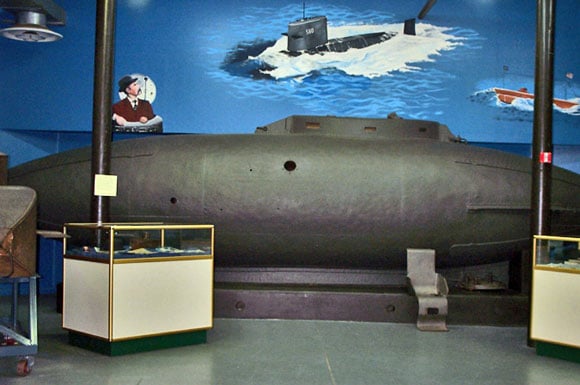
Paterson Museum
2 Market Street
Paterson, NJ 07501-1704
(973) 321-1260
Fax:(973) 881-3435
Email: [email protected]
http://patersonmuseum.com/
From Naval History Magazine, Sept./Oct. 1998:
There was a certain irony in the fact that Irishman Holland and Englishman Busch should end up working together. Holland’s first three submarine boats were financed from monies of the Skirmishing Fund of the Clan-na-Gael. The Clan was a wing of the Irish-American Fenian movement. The purpose was to devise an instrument of war to attack the British on the sea rather than on land in the Irish effort to achieve national independence. As remarkable as the submarine Fenian Ram proved to be, the “Saltwater Enterprise” ended in disaster for Holland and he shifted his allegiance to his adopted country.
Holland Boat #1
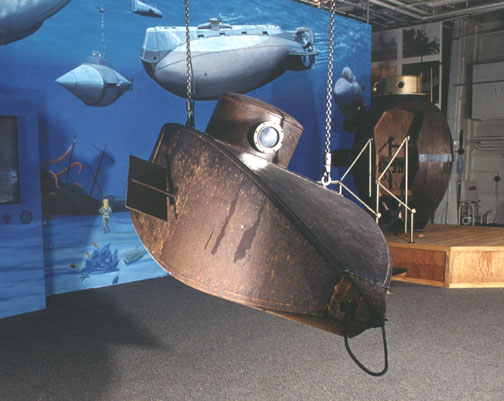
Paterson Museum
2 Market Street
Paterson, NJ 07501-1704
(973) 321-1260
Fax: (973) 881-3435
Email: [email protected]
http://patersonmuseum.com/
From Proceedings, Feb. 1943:
The Holland was regarded as the most important contribution to naval science so far devised. The submarine problem, which had beset experts for a century, had at last come within the field of practical and successful application. We wonder at the perfection the submersible has reached today, but it was the result of the labors of inventors wrestling with the idea long before the time of Bushnell and Fulton. Holland picked up the threads which others had lost or could not grasp. Thus submarine navigation was no longer the ineffective pursuit of cranks who had not mastered its fundamentals.
No longer a fad or a toy, the submarine became, in the shape of the Holland, a “monster war fish,” a “devil of the deep,” a “hell diver,” as the vessel came to be called. Strictly speaking, the boat was a torpedo, but a torpedo controlled in all its workings by human agency inside the craft, instead of being automatic in its operations. The ordinary torpedo, by an arrangement of springs to counteract the water pressure, was made to go through the water at any depth. It had to follow a path fixed for it beforehand. When it had run its course it came to the surface or sank, in accordance with a predetermined plan. The men inside the Holland controlled her at will.
Japanese Kaiten
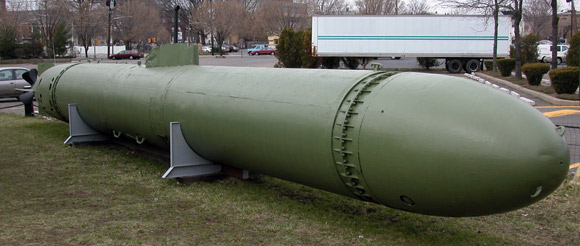
Submarine Memorial Association
78 River Street
Hackensack, NJ 07601-7110
(201) 342-3268
Email: [email protected]
http://www.njnm.org
From Proceedings, Jan. 1962:
By January 1943, the completed plans [for a manned torpedo] were ready. The enlarged Model 93 was now 54 feet long, would have a warhead of 3,000 pounds, and would range 40 miles at a top speed of 40 knots, without showing a wake. They even had a name for their invention, calling it kaiten. This translates literally as “sky change,” and its Japanese connotation is to make a revolutionary alteration, as though moving the heavens themselves.
USS Ling (SS-297)
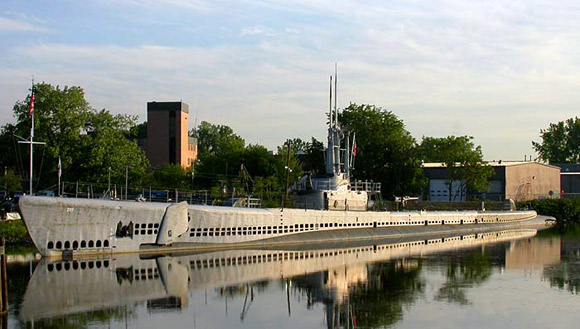
Submarine Memorial Association
78 River Street
Hackensack, NJ 07601-7110
(201) 342-3268
Email: [email protected]
http://www.njnm.org
From the Historic Naval Ships Association:
USS Ling is the last of the fleet boats that patrolled American shores during World War II in response to U-Boat attacks off the coast of the United States. Ling made one Atlantic patrol before the war ended. Decommissioned in 1946, Ling became part of the Atlantic Reserve Fleet until reactivation as a submarine training vessel in 1960.
Ling was donated to the Submarine Memorial Association in 1971, arriving at her present home in New Jersey in January 1973. The boat is now displayed in the narrow headwaters of the Hackensack River, and is the official state naval museum for New Jersey. Ling continues in service as a training aid for high school ROTC students. The memorial also includes displays of Polaris, Terrier, and Talos missiles; and three small craft: a Japanese Kaiten, a German Seehund, and a PBR Mark II. Ling conducts youth group overnight encampments.
USS New Jersey (BB-62)
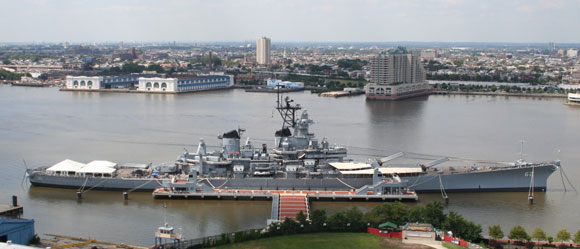
Battleship New Jersey Museum and Memorial
62 Battleship Place
Camden, NJ 08103-3302
(856) 966-1652
Fax: (856) 966-3131
Email: [email protected]
http://www.battleshipnewjersey.org
From Proceedings, Sept. 1968:
After 10 years in the reserve fleet, the USS New Jersey is again about to go to war. Sometime this month the 45,000-ton, 887-foot, 25-year-old battleship is expected to commence shore bombardment operations off Vietnam, just 13 months having passed since the Navy’s decision to return her to duty. Although the accelerated $21.5-million reactivation program conducted at the Philadelphia Naval Shipyard was largely limited to the minimum time and work necessary to ready the New Jerseyfor her shore bombardment role, some $6 million was devoted to updating her equipment to present standards. Major improvements include the installation of new radar and communications facilities, and the addition of air conditioning in all living and berthing spaces. The New Jersey was recommissioned at Philadelphia on April 6th, and in early June she moved to the West Coast via the Panama Canal. Her home port is Long Beach, California.
PBR Mark II
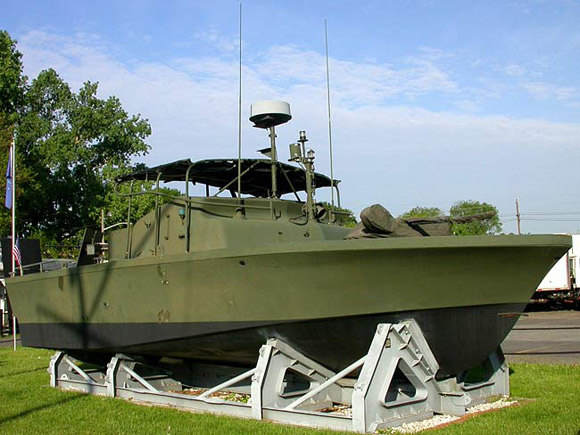
Submarine Memorial Association
78 River Street
Hackensack, NJ 07601-7110
(201) 342-3268
Email: [email protected]
http://www.njnm.org
From the Historic Naval Ships Association:
The PBR Mark II was designed for combat use in shallow inland waterways. The job of these small but heavily armed boats was interdiction of supplies and troops from North Vietnam. These PBR squadrons had the highest casualty rates and were the most decorated of all naval units in the Vietnam War.
German Seehund
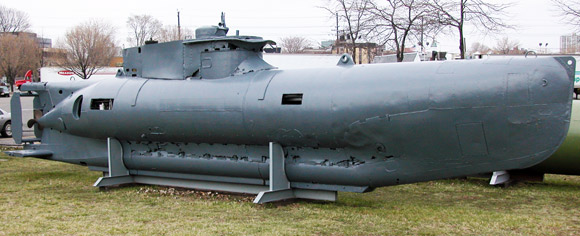
Submarine Memorial Association
78 River Street
Hackensack, NJ 07601-7110
(201) 342-3268
Email: [email protected]
http://www.njnm.org
From the Historic Naval Ships Association:
The Seehund (seal) was a successful coastal patrol design submarine. A total of 1,284 were ordered and 67 were built in 1944 and 1945. The Seehund was designed to be used in shallow water close to base, where reloads were available for quick turnaround and return to battle. The two torpedoes were slung externally on rails on each side of the boat.
Suffering extremely difficult working conditions, the Seehunds kept a considerable number of Allied ships and aircraft busy in the North Sea area in an effort to keep the midget threat in check. By the end of the war Seehunds had operated on 142 sorties, sinking nine merchant ships, damaging three ships and the sinking of one destroyer at the cost of 35 of their own number. The small U-boats were extremely difficult to destroy with depth charges and required swift direct hits from aircraft to be disabled.
New York
Fireboat John D. McKean, FDNY
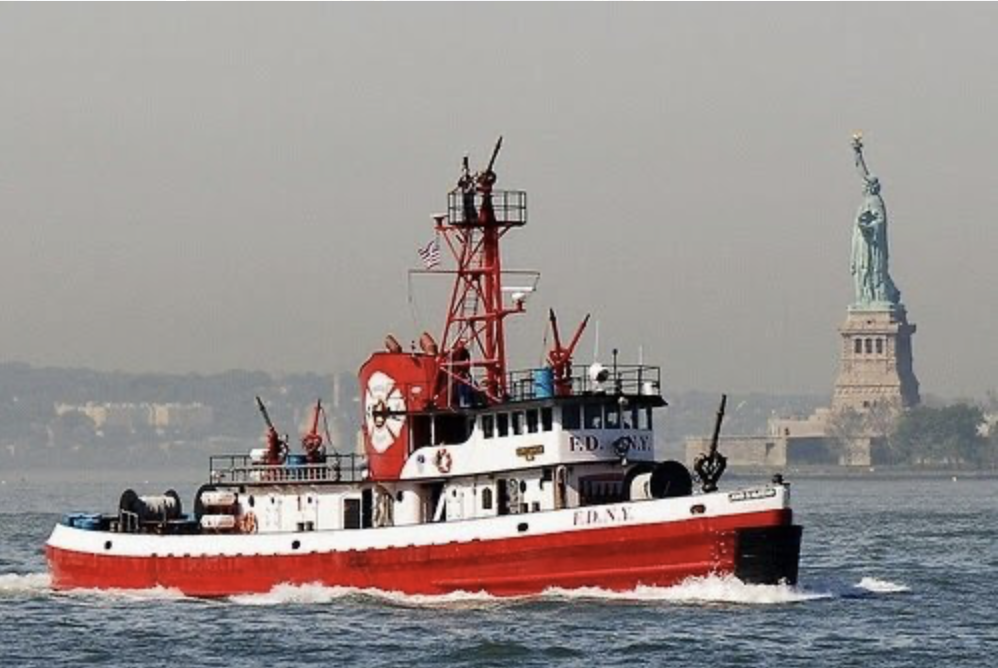
Fireboat McKean Preservation Project
P.O. Box 8342
Sleepy Hollow, NY 10591
(914) 906-1932
- Built in 1954 by John H. Mathis, Camden, NJ, for $1,426,000.
- Gross tonnage: 334.75
- Length: 129 feet, beam: 31 feet; draft 9 ½ feet, height above water including tower:47 ½ feet.
- Propulsion: two 1,000 HP Enterprise direct reversible diesel engines that provide a speed of 16 MPH. Two more 1,000 HP Enterprise engines drive four centrifugal pumps, with an output of 14,000 GPM.
In January 2009, the McKean responded to Captain Sully Sullenberger’s Hudson River landing of US Airways Flight 1549 during the Miracle on the Hudson, to rescue passengers and secure the plane from sinking.

In addition to emergency calls, the McKean ceremoniously welcomed runners to the New York City Marathon with a water display every year, assisted the USS Intrepid into its mooring, supervised the annual Macy’s Fourth of July Fireworks display barges and hosted numerous dignitaries. In continuing its ceremonial role, in August 2017 the McKean celebrated opening day for the new Gov. Mario Cuomo Bridge, hosting officials and conducting a water display.
The retired fireboat was purchased at auction in 2016 and the non-profit Fireboat McKean Preservation Project was formed in 2018 with the mission of preserving this magnificent vessel. It has been beautifully restored above deck by volunteers, and in the summer and fall of 2019 underwent a major repair of its hull at it’s home port the North River Shipyard in Upper Nyack, NY.
M/V Commander (SP-1247)
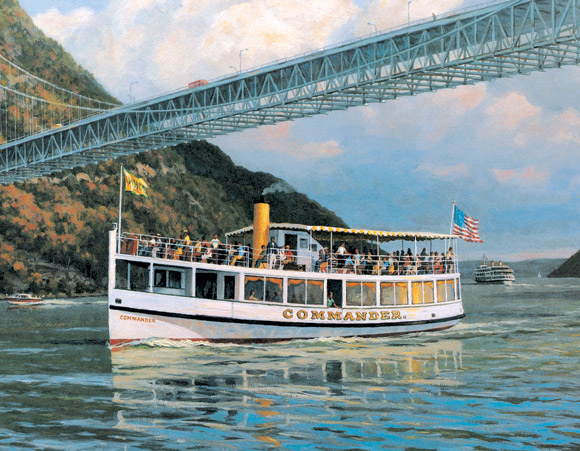
Hudson Highlands Cruises, Inc.
P.O. Box 355
Cornwall-on-Hudson, NY 12520
(845) 534-7245
Fax (845) 534-1083
Email: [email protected]
http://www.commanderboat.com
From the Historic Naval Ships Association:
Motor Vessel Commander was built as an excursion boat for service between Rockaway and Brooklyn, New York. In 1917, she was leased by the U.S. Navy and assigned to the Brooklyn Navy Yard to outfit submarine chasers and tow manned observation balloons off the entrances of New York Harbor in search of German submarines.
She was decommissioned and returned to her owners in 1919. She then began an eight decade career with the Rockaway Boat Line, one of the longest uninterrupted services in excursion boat history in the United States. She is now operated in the Hudson River Highlands as an excursion vessel.
Commander is the only former U.S. Naval vessel of World War I vintage still operating under her own motor power and in its original condition. She proudly displays the World War I Victory Medal.
MV Commander is on the National and New York Registers of Historic Places.
USS Croaker (SS-246)
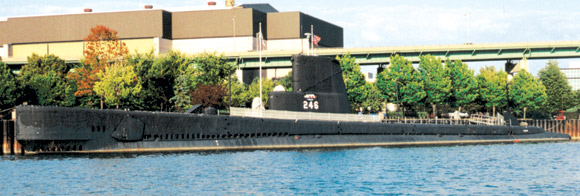
Buffalo & Erie County Naval & Military Park
One Naval Park Cove
Buffalo, New York 14202
(716) 847-1773
Fax: (716) 847-6405
Email: [email protected]
http://www.buffalonavalpark.org/
From Naval History Magazine, Summer 1990:
The Buffalo and Erie County Naval and Servicemen’s Park in Buffalo, New York, features a World War II destroyer and submarine, a guided-missile cruiser, an Army tank, a Marine Corps personnel carrier, an Air Force jet, and 43 ship models. Its purpose is to represent the U.S. armed forces, and to help educate the public about their purpose and history.
The most recent addition to the historical naval display is the submarine Croaker (SSK-246). Built by Electric Boat and commissioned in 1944 as a Gato (SS-212)-class submarine, she served in the Pacific on six World War II patrols. She joined in U.S. submarine operations against Japanese merchant vessels and combatants by sinking 11 vessels for a total of 40,000 tons. She was awarded a Navy Unit Commendation for the first war patrol under Commander John E. Lee.
The Croaker underwent a hunter-killer conversion in 1953 and was redesignated SSK-246. The program featured the addition of a streamlined sail, snorkel, longrange sonar, and machinery noise reduction. After patrolling the Caribbean, Mediterranean, and Atlantic between 1953 and 1968, the Croaker served as a training vessel until 1971, when she was decommissioned.
Later transferred as a memorial vessel to the Submarine Memorial Association at Groton, Connecticut, the Croakerlived on as a memorial with her arrival in Buffalo in 1988, when work began to restore her.
USS Growler (SSG-577)
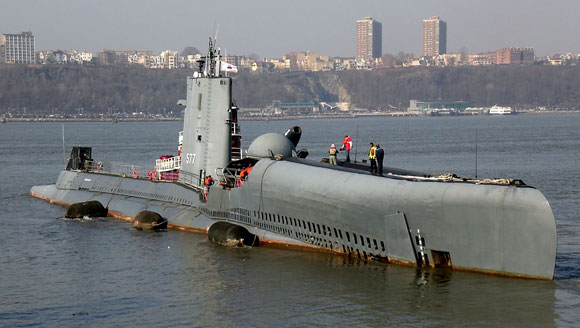
Intrepid Sea-Air-Space Museum
Pier 86
West 46th Street & 12th Avenue
New York, New York 10036-4103
(212) 245-0072
Fax: (212) 245-7289
http://www.intrepidmuseum.org
From Naval History Magazine, Aug. 2003:
The Tomahawk land attack missile of today traces back to a 50-year-old weapon. In 1953, the guided-missile submarine Tunny ushered in a new era, successfully firing a nuclear-capable missile-the Regulus I.
The Navy was eager to deploy its new strategic weapon, and plans were quickly made to build five nuclear submarines to carry the missile. The first, the USS Halibut (SSGN-587), would be launched in 1959. In the meantime, the Navy decided to convert existing diesel submarines into guided-missile submarines (SSGs). The Tunny and USS Barbero (SSG-317), both World War II fleet boats, were outfitted with hangars capable of holding two missiles. The USS Grayback (SSG-574) and USS Growler (SSG-577), which were originally intended as Tang (SS-563)-class attack boats, received twin hangars capable of holding four missiles. The Navy also modified four Baltimore (CA-68)-class cruisers to carry the Regulus, and several aircraft carriers deployed either with missiles or with aircraft capable of guiding Regulus missiles to target.
In October 1959, with the Grayback and the Growler in commission and the Halibut nearly ready, the Navy consolidated the Regulus submarines in Pearl Harbor. The Regulus boats now would form a deterrent shield. Their targets, presumably, were the Soviet Union’s Pacific submarine and naval bases, and their new mission was to maintain peace through the threat of mutual assured destruction. “It was all top-secret, code-word stuff,” says Captain Bill Gunn, who served in the Grayback. “No one in Pearl Harbor knew what we were doing.”
USS Intrepid (CV-11)
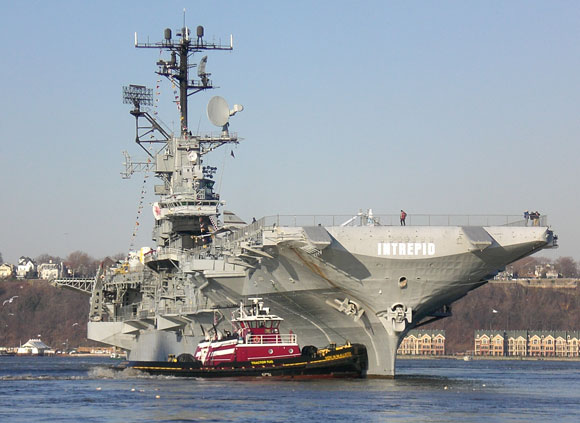
Intrepid Sea-Air-Space Museum
Pier 86
West 46th Street & 12th Avenue
New York, New York 10036-4103
(212) 245-0072
Fax: (212) 245-7289
http://www.intrepidmuseum.org
From Naval History Magazine:
The second attempt to move the USS Intrepid (CV-11) from her Hudson River pier proved to he as much a nailbiter as the first a month earlier, but the outcome this time was positive. On 5 Decemher, tour high-powered tugboats managed to move the historic aircraft carrier about eight feet back and five feel out from her dock before she got stuck in the mud. (This had also happened on the tirst attempt, on 6 November.) But then, after a struggle of more than 30 minutes, the tugs yanked the 29,000-ton famed ship from Pier 86, where she had been docked for 24 years. The move was designed to allow the Intrepid and her berth to undergo a $60-million, two-year refurbishing.
As the carrier was willed free of mind that clung to her propellers and began to clear the end of the pier, Bill White, president of the Intrepid Sea, Air & Space Museum, urged the 920-foot vessel on.
“Come on, baby! Come on, baby!” he shouted. “We’ll see you in Bayonne,” he yelled to employees watching from the pier, referring to the intended destination five miles down the river and across the harbor in New Jersey, where the Intrepid will begin her overhaul. When the ship was finally out in the river, White and tug coordinator Captain Pat Kinnier began jumping up and down, whooping, and giving each other high fives.
“We’re excited,” White said. “It’s a great day.”
The Intrepid, launched in 1943, is one of four Essex (CV-9) -class carriers still afloat. She served during World War II, the Korean, and Vietnam Wars, and as a recovery ship for NASA astronauts. Headed for the scrapyard, she was purchased in 1981 by real estate developer Zachary Fisher and, until this move, attracted 700,000 visitors a year.
USCGC Lilac (WAGL-227)
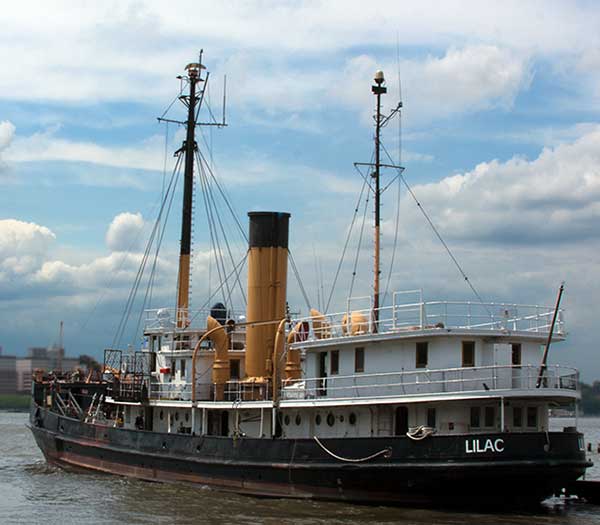
Hudson River Park’s Pier 25 on the west side of Manhattan
New York, NY
(917) 709-5291
Email: [email protected]
http://lilacpreservationproject.org/
From the Historic Naval Ships Association:
Laid down at the end of the tenure of the U.S. Lighthouse Service, Lilac transferred to the Coast Guard when it was took over the Lighthouse Service in 1939. Between 1892 and 1939 thirty-three of these lighthouse tenders were built, most ranging in length from 164 to 174 feet.
She was assigned to the Fourth Lighthouse District, which covered the Delaware River from Trenton, New Jersey south to the mouth of Delaware Bay, replacing the tender Iris of 1899. Her base was located in Edgemoor, Delaware, just north of Wilmington until 1948, when it was shifted to Gloucester, New Jersey, just below Philadelphia.
In addition to maintaining the aids to navigation in the Fourth Lighthouse District, the Lilac was involved in rescue and fire fighting efforts during a number of marine disasters. During abnormal ice conditions in the winter of 1935-36, the tenders Lilac and Violet were sent into the Lower Delaware Bay to evacuate the keepers on endangered offshore lighthouses. The Lilac was on hand from the 15th to the 17th of May 1952 following the collision of the cargo ship Barbara Lykes and the coastal tanker F. L. Hayes. The F. L. Hayes sank on fire in the center of the Chesapeake and Delaware Canal. The Lilac was involved again from the 6th to the 12th of June 1953 following the spectacular collision and fire of the tankers Phoenix and Pan Massachusetts at the Delaware Bay end of the Canal. The following month she spent two days fighting a fire on the tanker Pan Georgia in the Christina River near Wilmington.
The Lilac was decommissioned on 3 February 1972, by which time she was the last steam-powered lighthouse or buoy tender in the Coast Guard fleet. From 1972-1984 she was used by the Seafarers International Union as a stationary training facility for union members upgrading within the non-officer positions in bridge or engine room. In 1984 the Lilac was retired from this work and turned over to the Atlantic Towing Corporation of Norfolk, Virginia. On 3 April 1985 she was sold to Henry A. Houck, operator of a salvage yard on the James River near Richmond, Virginia. She remained virtually unaltered, retaining most of her original fittings and equipment, through the period at Piney Point and the period in the salvage yard, where she was primarily used as office space.
USS Little Rock (CL-92 then CLG-4)
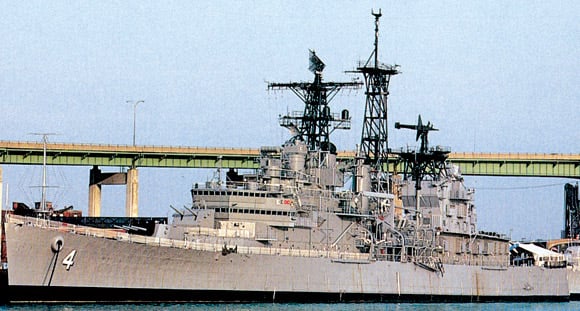
Buffalo & Erie County Naval & Military Park
One Naval Park Cove
Buffalo, New York 14202
(716) 847-1773
Fax: (716) 847-6405
Email: [email protected]
http://www.buffalonavalpark.org/
From Naval History Magazine, summer 1990
To represent the peacetime U.S. Navy, the guided-missile cruiser Little Rock (CLG-4) seemed a good candidate. The Naval Park Committee believed that there was limited exposure to the worldwide peacetime forces that carry out the stated U.S. naval mission of being “prepared to conduct operations at sea in support of United States national interests,” a mission the Little Rock performed from 1960 to 1975. The ship served as flagship for commanders of the U.S. Second and Sixth fleets stationed in the Atlantic and the Mediterranean. The LittleRocksymbolized modern U.S. Navy efforts to comply with Theodore Roosevelt’s exhortation: “Speak softly and carry a big stick; you will go far.”
The Little Rock‘s peacetime service included participation in the Cuban Missile Crisis blockade in 1962; rescue of flood victims from Tunisia in 1973; and participation in the Suez Canal reopening in 1975. The ship carried one of the Navy’s first versions of guided-missile technology on board ship. Her conversion from a Cleveland (CL-55)-class all– gun World War II cruiser, with 12 sixinch and 12 five-inch guns and seaplanes, began in 1957 and was completed in 1960. The primary weapon system on board became the Talos missile. Developed out of the Bumblebee program along with the Terrier and Tartar missiles, the Talos had a range of 65 miles and was fired at a speed greater than Mach 2.
Both The Sullivans and the Little Rock arrived in Buffalo in 1977; two years of preparation for public viewing followed.
USAT LT-5
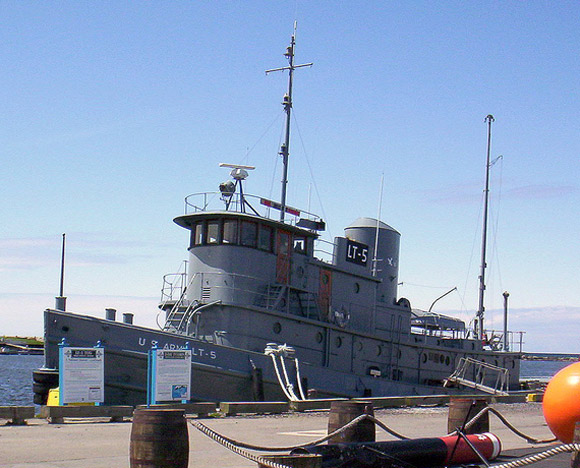
H. Lee White Maritime Museum
P.O. Box 101
West First Street Pier
Oswego, New York 13126
(315) 342-0480
Fax: (315) 343-5778
Email: [email protected]
http://www.hleewhitemarinemuseum.com
From the Historic Naval Ships Association:
Built to serve during WW II, USAT LT-5 moved military cargo under the Army Transportation Corps. She served in both the Atlantic and Pacific. On February 3, 1944, she sailed for Great Britain to assist in the preparations for Operation Overlord. LT-5 arrived off the Normandy coast on June 7 as part of Operation Mulberry. On June 8th while moored to a sunken LST, LT-5 was subjected to air attacks. Her log book for June 9 records that at 20:30 hours, “planes overhead. Everyone shooting at them. Starboard gunner got an F.W.” (German Luftwaffe fighter, the Focke Wulf.)
While many of the Army’s remaining tugs were decommissioned, sold or scrapped, LT-5 was assigned to the Army Corps of Engineers out of Buffalo serving from 1946 until 1989 as a Great Lakes harbor tug. She is the only known essentially unmodified example of the LT-type left in the U.S. Her heroics during the Normandy invasion led to the awarding of National Historic Landmark status in 1991.
LT-5 is berthed on the West Pier in the Oswego Harbor where she is made available for public viewing through the H. Lee White Museum. The museum is open seasonally from May through September.
PT-615
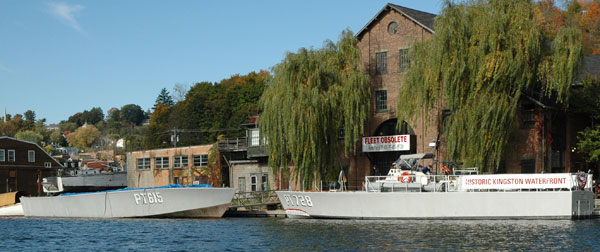
Fleet Obsolete on the Kingston Waterfront
110 East Strand
Kingston, NY 12401
Phone: 718-596-0504
Fax: 718-596-6443
http://fleetobsolete.org/
From Naval History Magazine, Oct. 2014:
Primarily designed for high-speed torpedo attacks against much larger adversaries, PT boats fulfilled a host of vital roles in the Pacific, English Channel, and Mediterranean during World War II.
More than 500 PT boats were built in American yards during the war. With the exception of 36 that were loaned to Britain and the Soviet Union under the Lend-Lease program, all served for varying lengths of time under U.S. colors. About 350 PTs served in the Pacific theater, 42 in the Mediterranean, and 33 in the English Channel.
The Navy conceived and built the PT as a torpedo boat, yet this function was never fully achieved as the war progressed. The Royal Navy’s experience with its MTBs was similar. Despite their other valuable functions, the 464 PT boats serving with the U.S. Navy in 1942–45 fired only about 700 torpedoes. The majority of PTs, in fact, each fired less than two torpedoes.
Yet, as her torpedo function waned during the war, the PT boat was called upon to fulfill a host of vital roles in the three major theaters. Her sleek hull and engine power provided the Allies with a ready shallow-draft gun platform—fast, seaworthy, and highly maneuverable—for harassing enemy coastal traffic, shore installations, and small craft, rather than attempting virtually suicidal forays against capital ships. The PT boat became strictly a gunboat, and, as such, distinguished herself as a highly versatile combat vessel.
PTF-17
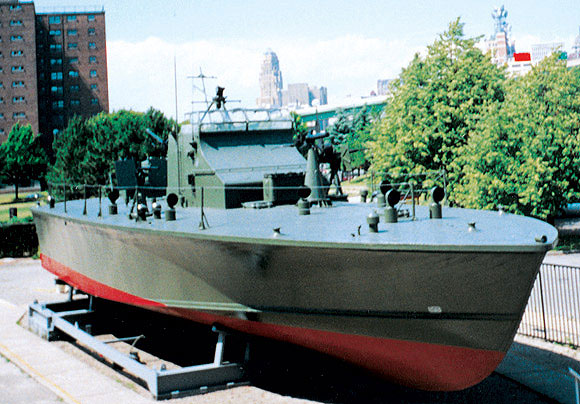
Buffalo & Erie County Naval & Military Park
One Naval Park Cove
Buffalo, New York 14202
(716) 847-1773
Fax: (716) 847-6405
Email: [email protected]
http://www.buffalonavalpark.org/
From Naval History Magazine, Summer 1990:
The Buffalo and Erie County Naval and Servicemen’s Park in Buffalo, New York, features a World War II destroyer and submarine, a guided-missile cruiser, an Army tank, a Marine Corps personnel carrier, an Air Force jet, and 43 ship models. Its purpose is to represent the U.S. armed forces, and to help educate the public about their purpose and history.
Other park displays include an Army M41 Walker Bulldog tank, a Marine Corps M-84 armored personnel carrier, an Air Force F-101 Voodoo jet, a Navy FJ-4B Fury jet, and a patrol boat in the form of PTF-17.
USS Slater (DE-766)
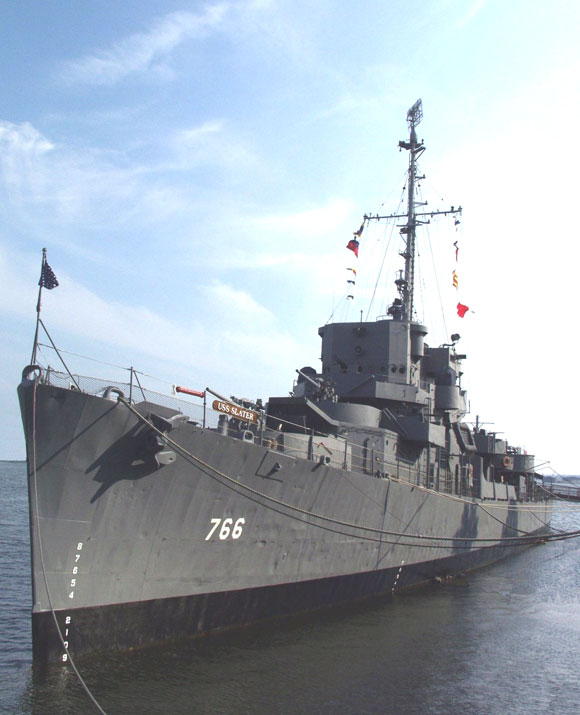
Destroyer Escort Historical Museum
USS Slater
Broadway and Quay Streets
Albany, NY 12202
(518) 431-1943
Fax: (518) 432-1123
Email: [email protected]
http://www.ussslater.org
From Naval History Magazine, Oct. 2014:
On 30 June, the USS Slater (DE-776) began her voyage from Staten Island’s Caddell Drydock and Repair Company up the Hudson back to her permanent home in Albany, New York, where she will serve as the Destroyer Escort Historical Museum dedicated to the “DEs” of World War II. Destroyer escorts were built to address the shortage of antisubmarine vessels in the Atlantic at the beginning of the war. The United States developed the warship based on the British Hunt-class destroyer and went on to build 536 such vessels between 1943 and 1945. These small destroyers had heavy antisubmarine and antiaircraft weapons as well as electronics to detect the enemy; they were maneuverable, fast, and could operate at long range. Today there are fewer than 12 surviving Cannon-class destroyer escorts, and the Slater is the only one still afloat and with her World War II configuration.
Commissioned in May 1944, the Slater served as a target and sonar school ship before being assigned to Atlantic convoy duty. After the Allied victory in Europe, she escorted convoys in the Pacific before she was deactivated in April 1946. In 1951 she was transferred to the Hellenic Navy, renamed the Aetos, and sailed in Greek service until 1991.
In 1993 the Destroyer Escort Sailors Association, which had recently established the Destroyer Escort Historical Museum, raised $290,000 to bring the Slater back home. She was towed from Crete to New York by a Ukrainian tug, and in 1997 she moved from New York City to Albany. Over the past 15 years she has been restored to her 1945 condition, a sizeable effort that included the removal of all Greek modifications, the installation of authentic World War II naval equipment, and work on her hull, deck, and bulkheads.
USS The Sullivans (DD-537)
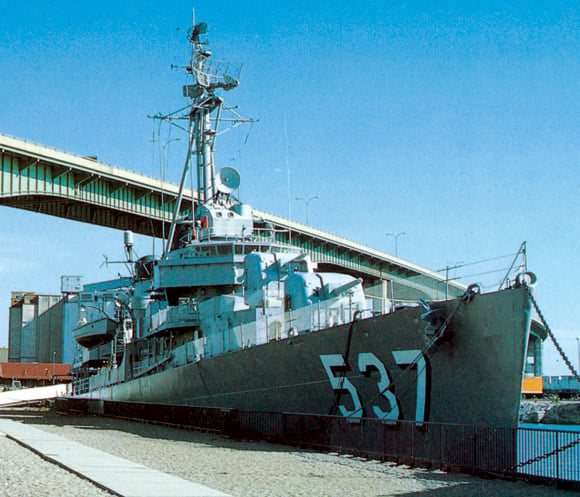
Buffalo & Erie County Naval & Military Park
One Naval Park Cove
Buffalo, New York 14202
(716) 847-1773
Fax: (716) 847-6405
Email: [email protected]
http://www.buffalonavalpark.org/
http://www.ussthesullivans.net/
From Naval History Magazine, Summer 1990:
Determined to honor western New Yorkers who had served or were serving in the U.S. armed forces, in 1977 Buffalo City Court Judge Anthony LoRusso obtained approval for transfer of a mothballed destroyer, The Sullivans(DD537), from Philadelphia to Buffalo. The destroyer was named for the five Sullivan brothers who lost their lives when the cruiser USS Juneau (CL-52) was sunk near Guadalcanal on 13 November 1942.
In 1943, President Roosevelt mandated that one of the Fletcher (DD-445)-class destroyers then in production be named after the brothers, and the Putnam, not yet commissioned, was renamed The Sullivans. Parents Thomas and Alletta Sullivan sponsored and launched the ship; later, they visited production facilities across the country to sell war bonds and boost the morale of those producing war materiel.
During World War II, The Sullivans earned nine battle stars for Pacific action; she earned two more during the Korean War. She and other destroyers of the time performed numerous tasks for U.S. fleets worldwide, serving as radar pickets and conducting antisubmarine warfare.
North Carolina
USS North Carolina (BB-55)
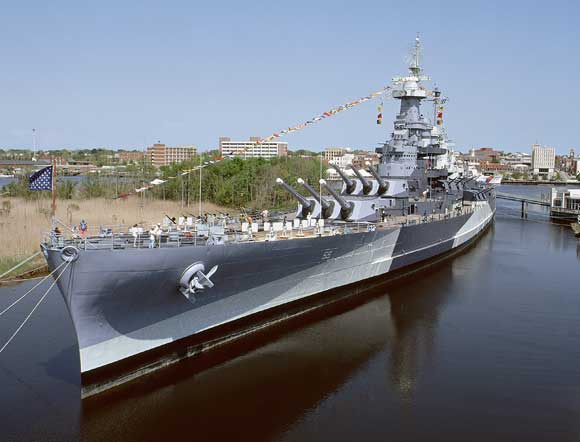
North Carolina Battleship Memorial
PO Box 480
Wilmington, NC 28402
(910) 251-5797
Fax: (910) 251-5807
Email: [email protected]
http://www.battleshipnc.com/
From Naval History Magazine, Winter 1988:
“You, out there, steel and steam,” the accusing voice from the past bellows, “What have you done with my name, North Carolina?”
The question, directed at the 729-foot– long battleship North Carolina (BB-55), booms out from several loudspeakers in front of the grandstand and echoes across the Cape Fear River toward Wilmington. It heralds the start of another evening’s sound-and-light show. During the following 60 minutes, the question is answered in spectacular fashion. The forward 16-inch and port 5-inch guns and several 40-millimeter mounts once again blaze away at enemy targets. (The guns now use kerosene instead of powder bags.) Even the bow 20-millimeter mounts rattle out in desperate defiance at the imaginary aircraft that have come too close for comfort.
Although it is now the newer Iowa– class battleships that are once again in the public eye as part of the fleet, there was a time when photographs of theUSS North Carolina could be found in just about every newspaper across the country. As the first U. S. battleship commissioned since the West Virginia (BB-48) in 1923, and the first of the fast battleships, the North Carolina and her sister ship Washington (BB-56) set the standard for America’s new battle fleet. From her keel laying on 27 October 1937 at the New York Navy Yard, through her commissioning on 9 April 1941 and the builder’s trials that followed, the media coverage was almost nonstop. As a result, the North Carolina was nicknamed “The Showboat.” It was a name that would stick with her through her active service and long after.
Ohio
USS Cod (SS-224)
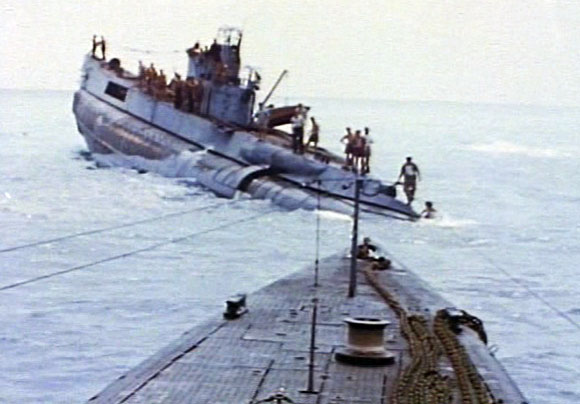
USS Cod Submarine Memorial
1089 East 9th Street
Cleveland, Ohio 44114
(216) 566-8770
Email: [email protected]
http://www.usscod.org
From Naval History Magazine, April 2009:
Want to see what life was really like in a World War II submarine? Then take a trip to the Lake Erie waterfront in Cleveland, Ohio, to the USS Cod (SS-224) Memorial. Secured to a pier there is the 312-foot Gato -class fleet submarine, which was commissioned 21 June 1943 at Groton, Connecticut. During World War II, she completed seven successful Pacific patrols, claiming 15 ships sunk and five damaged.
As a museum ship, she is unique among U.S. World War II submarine displays in that she is the only one that has not had her pressure hull cut open for public access. The only way a visitor gets on or off the boat on the self-guided tour is by way of the same hatches and vertical ladders used by her crew.
SS William G. Mather
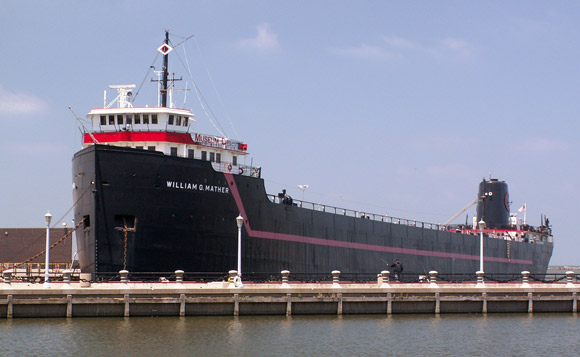
Great Lakes Science Center
601 Erieside Avenue
Cleveland, Ohio 44114-1021
(216) 574-6262
Fax: (216) 574-2536
Email: [email protected]
http://www.greatscience.com/mather_museum.php
From the Historic Naval Ships Association:
The Steamship William G. Mather was built during the golden years of American lakes steamboats. As the flagship for the Cleveland Cliffs Iron Company, she was state-of-the-art with respect to capacity, power, and accommodations. During her 55-year career, she carried millions of tons of iron ore, coal, grain, and distinguished guests, and was nicknamed “The Ship That Built Cleveland” because Cleveland’s steel mills were a frequent destination.
In 1941 the Mather led a convoy of 13 freighters through the ice-choked upper Great Lakes to Duluth, Minnesota, to begin supplying badly needed iron ore to U.S. steel mills as they geared up to support president Roosevelt’s pledge that America would be the “Arsenal of Democracy” prior to our entry into World War II. The trip set a record for the earliest arrival of a bulk carrier in a northern port. This heroic effort was featured in the April 28, 1941 issue of Life magazine.
Retired from service in 1980, Mather underwent an extensive restoration program beginning in 1987 and was opened for public tours in Cleveland’s Northcoast Harbor in 1991. In 1995 the American Society of Mechanical Engineers conferred Historic Engineering Landmark status on Mather for the following technological Great Lakes firsts: single marine boiler system, boiler automation, and dual bow thruster system.
Oklahoma
USS Batfish (SS-130)
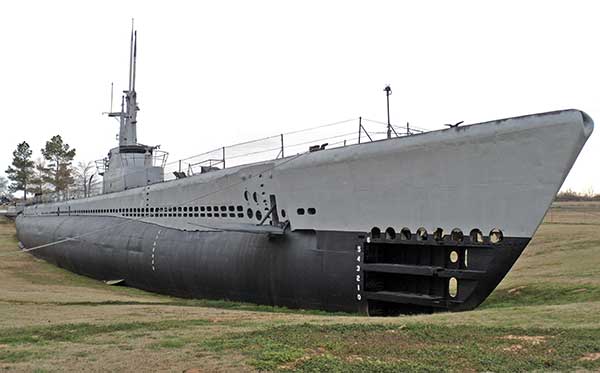
Muskogee War Memorial Park
3500 Batfish Road
P.O. Box 253
Muskogee, OK 74402
(918) 682-6294
E-mail: [email protected]
http://www.ussbatfish.com
From Naval History Magazine, Dec. 2014:
Over the course of several nights in February 1945, what had been a slow and disappointing war patrol for the Batfish turned into a record-setting mission.
After almost three weeks in a very unproductive spot we were given orders to proceed north of Luzon. We were told that five submarines were being used for evacuation of officials from Luzon, carrying them up to Formosa. Fortunately, we were provided with rough departure dates and a fairly good course, or track, for the enemy submarines. After three days in the area, one night we picked up what we all soon recognized as Japanese submarine radar 158 on our APR. We closed in and finally picked him up on the radar itself, made a pretty fine pip, and we closed in for an approach.
We made an end around run, decided to make a surface approach from his bow, trying to get a 90-degree-track, zero-gyro shot. This we were able to do. We reached a position about 1,200 yards on his beam, closed in, fired three torpedoes, one of which hit and undoubtedly sank this particular submarine.
We sighted him just about the time of firing, and he was positively identified as a submarine, and we believe he was just commencing a dive. He must have seen us at the same time, but our torpedoes got to him before he got down. We were pretty happy about this, because even just sinking one small Japanese submarine makes a pretty successful patrol. I don’t think there’s a more nerve-racking thing in this business than one submarine chasing another one. We all had the “jits” pretty badly about it the next day, thinking he could have gotten us just as easily as we had gotten him.
Oregon
USS Blueback (SS-581)
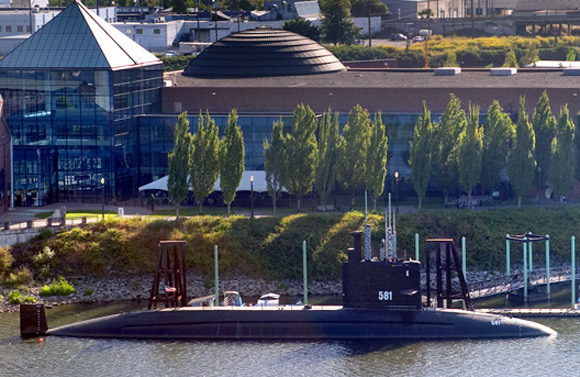
Oregon Museum of Science and Industry
1945 SE Water Avenue
Portland, Oregon 97214 -3354
(503) 797-4000
Fax: (503) 797-4500
Email: [email protected]
http://www.omsi.edu/submarine
From Naval History Magazine, Aug. 2002:
As she rests quietly beside the floating dock of the Oregon Museum of Science and Industry (OMSI), the Blueback (SS-581) continues her service to flag and country. Her message is twofold: the preservation of our heritage and the protection of our future. She speaks of pre– cise technology, strategic maneuvering, service, and protection. She speaks also of environmental conservation. The road to the scrap yard too often is traveled by the steel veterans of our history. The Blueback continues to fly her flag and her presence is a remembrance from our past and a herald to our future.
The Blueback was the last nonnuclear– powered submarine built by the U.S. Navy, commissioned in 1959. A trim 219 feet long, she displaced less than 2,700 tons fully submerged. Her ability to cruise 19,000 miles without refueling contributed to the record she set in September 1961, when she traveled 5,340 miles from Yokosuka, Japan, to San Diego en– tirely submerged. Even after she was decommissioned following 31 years of ser– vice, she caught the eye of millions of moviegoers when she appeared in the movie based on Tom Clancy’s novel The Hunt for Red October. Her service did not end there, however. In their literature fo– cusing on the Blueback, OMSI paid trib– ute to the many people who worked for more than three years to ensure she would continue to serve as a memorial to submariners and for the enjoyment of fu– ture generations. She was acquired by the museum in 1994, and underwent a major overhaul in 1998.
LCI(L)-713
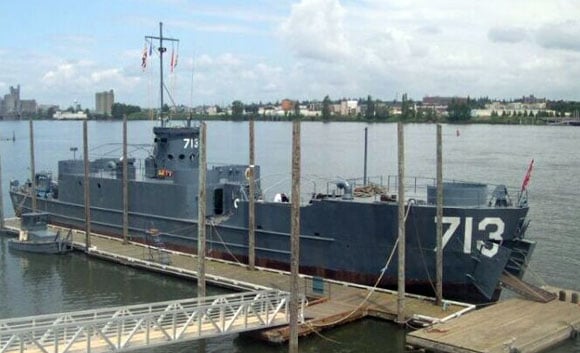
Amphibious Forces Memorial Museum
5331 S Macadam Ave
Ste 258 PMB 1085
Portland, OR 97239-3871
541-226-5427, 503-577-6627, 503-334-7365
Email:
[email protected]
From the Historic Naval Ships Association:
LCI(L)-713 was built by George Lawley & Sons Shipyards in Neponset, Massachusetts in 1944 to land up to 200 soldiers onto any beach in the world. After shakedown and training cruises at Solomons, Maryland, she sailed through the Panama Canal to the Pacific Theater of Operations where she earned a battle star while assigned to Flotilla 24. She participated on two combat landings on Mindanao and Borneo before the end of World War II. From then on until December 1945 she transported troops, mail and supplies around the Philippines.
She sailed back to the United States in January 1946. She was decommissioned on October 6th, 1946 and released to the Maritime Commission for sale. On February 10th, 1948, the ship was purchased at government auction by C. T. Smith & Son, a log-towing company, and picked up from the Navy in Seattle. After a two day trip to Portland, Oregon, it was found that she would not be practical for towing logs so she was docked and for several years used for stowing gear and fuel.
The LCI(L)-713 eventually settled to the bottom becoming a breakwater in the Columbia River near the town of Stevenson, Washington. Arthur A. Raz acquired the ship in 1976, raised the ship and towed it to Portland, Oregon. She remained in Portland until 1998 when Walt James purchased the ship from the estate of Mr. Raz and began a restoration effort. In 2003 a non-profit 501(c)(3) corporation under the name of the “Amphibious Forces Memorial Museum” was formed in order to keep the LCI(L)-713 as a museum ship for current and future generations. The museum acquired the ship from Mr. James in December, 2003. The museum has a complement of volunteers that include electricians, maritime industry welders, students, entrepreneurs and several WW II amphibious veterans who share a common interest in bringing the ship back to her original war-time condition. They are proud to be involved in the restoration of this ship. The LCI(L)-713 is the last remaining LCI(L) in its original WW II configuration.
PT-658
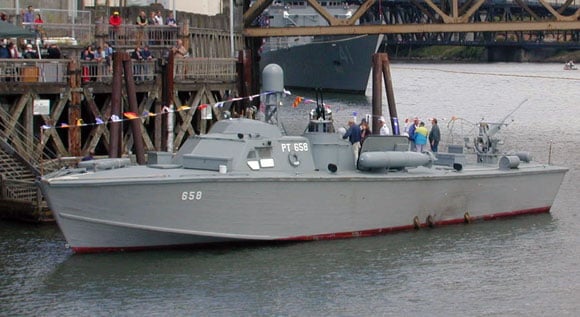
Naval & Marine Corps Reserve Center
Swan Island
6735 N Basin Ave, Portland, OR 97217
Tel: (503)285-4566
Fax: 1-503-581-0716
Email:
Wally Boerger: [email protected] (webmaster)
Frank Lesage: [email protected]
Jerry Gilmartin [email protected]
http://www.savetheptboatinc.com/
From Naval History Magazine, Oct. 2014:
Primarily designed for high-speed torpedo attacks against much larger adversaries, PT boats fulfilled a host of vital roles in the Pacific, English Channel, and Mediterranean during World War II.
More than 500 PT boats were built in American yards during the war. With the exception of 36 that were loaned to Britain and the Soviet Union under the Lend-Lease program, all served for varying lengths of time under U.S. colors. About 350 PTs served in the Pacific theater, 42 in the Mediterranean, and 33 in the English Channel.
The Navy conceived and built the PT as a torpedo boat, yet this function was never fully achieved as the war progressed. The Royal Navy’s experience with its MTBs was similar. Despite their other valuable functions, the 464 PT boats serving with the U.S. Navy in 1942–45 fired only about 700 torpedoes. The majority of PTs, in fact, each fired less than two torpedoes.
Yet, as her torpedo function waned during the war, the PT boat was called upon to fulfill a host of vital roles in the three major theaters. Her sleek hull and engine power provided the Allies with a ready shallow-draft gun platform—fast, seaworthy, and highly maneuverable—for harassing enemy coastal traffic, shore installations, and small craft, rather than attempting virtually suicidal forays against capital ships. The PT boat became strictly a gunboat, and, as such, distinguished herself as a highly versatile combat vessel.
Pennsylvania
USS Becuna (SS-319)
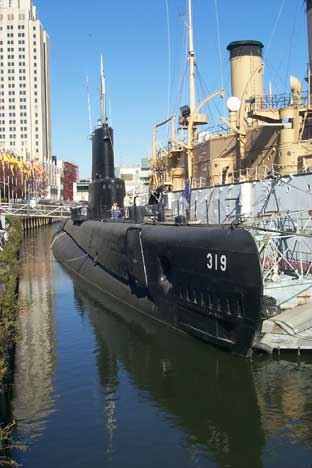
Independence Seaport Museum
211 South Columbus Blvd. at Penns Landing
Philadelphia, PA 19106-3199
(215) 925-5439
Fax: (215) 925-6713
Email: [email protected]
http://www.phillyseaport.org
From Naval History Magazine, Winter 1989:
During World War II, the Becuna made five war patrols in the Pacific and is credited with sinking the 1,943-ton freighter Tokuwa Maru, a 2,000-ton tanker, and two sea trucks.
In November 1950, following several years of postwar service, she entered the yard of Electric Boat Company for a “Guppy (greater underwater propulsive power) 1A” conversion, during which she received additional batteries, a snorkel, and a streamlined sail and superstructure. The Guppy program resulted from studies done on captured German Type XXI submarines. The Becuna completed her conversion in August 1951 and operated for the next 18 years from her home in New London.
She was placed out of commission, in reserve, on 7 November 1969 at the Philadelphia Naval Shipyard. On 15 August 1973, her name was struck from the Navy list. She was donated to the Cruiser Olympia Association on 21 June 1976 as a memorial. Having come straight from the reserve fleet in Philadelphia, she is one of the most complete submarine memorials on display. Her appearance was further enhanced from material obtained from the now-scrapped Wahoo (SS-565).
U.S. Brig Niagara
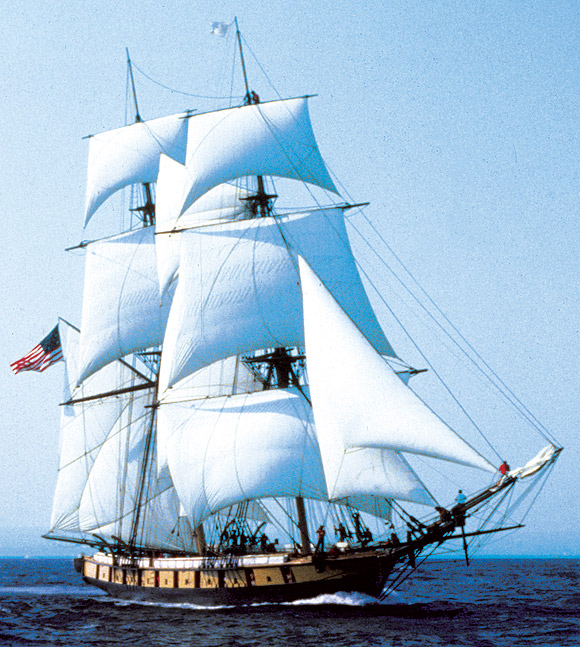
150 Front Street, Suite 100
Erie, PA 16507
(814) 452-2744
Fax: (814) 455-6760
Email: [email protected]
http://flagshipniagara.org/
USS Olympia (C-6)
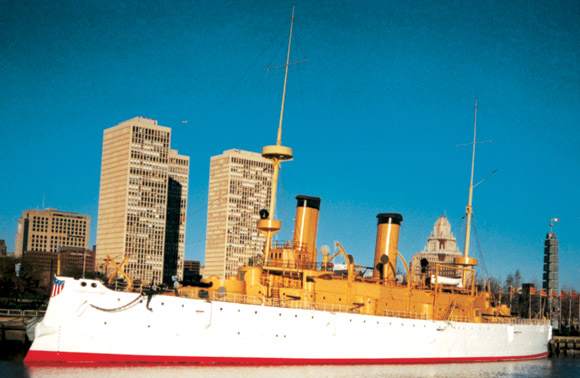
Independence Seaport Museum
211 South Columbus Boulevard at Walnut Street
Philadelphia, PA 19106-3199
(215) 925-5439
Fax: (215) 925-6713
Email: [email protected]
http://www.phillyseaport.org
From Naval History Blog, Nov. 2013:
She served as the flagship during the Spanish American War, Caribbean Division in 1902, the U.S. Patrol Force in 1917 and American Naval Forces in the Mediterranean in 1919.
But USS Olympia’s most memorable overseas mission was her last: carrying the body of theUnknown Solider for burial at Arlington National Cemetery in 1921.
Just like the sailors, Marines, airmen and soldiers of today, the last steel-hulled cruiser played her part in leaving no warrior behind and giving solemn passage home for those who made the ultimate sacrifice in protecting their country.
USS Requin (SS-481)
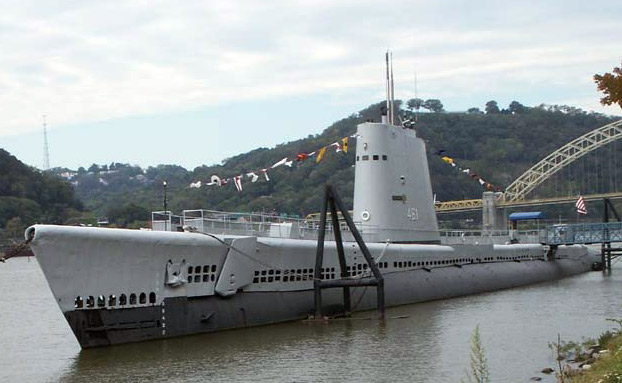
Carnegie Science Center
1 Allegheny Avenue
Pittsburgh, Pennsylvania 15212
(412) 237-1550
Fax: (412) 237-3375
http://www.carnegiesciencecenter.org/default.aspx?pageId=38
From Naval History Magazine, Summer 1990:
The Secretary of the Navy has signed the transfer document for the Tench-class submarine Requin (SS-481) to move from Tampa, Florida, to the care of the Carnegie Institute, Pittsburgh, Pennsylvania. She is scheduled for a journey up the Mississippi and Ohio rivers to the “steel city” this summer. Elsewhere, the U– 505, a captured German World War II submarine on display outside the Museum of Science and Industry in Chicago since 1953, has undergone preservation treatment. Washington University Technology Associates of St. Louis, Missouri, one of the leading groups in the country in outdoor sculpture conservation, found the submarine “in a highly deteriorated condition” in 1988. Their treatment has focused on long-term stabilization of the hull and future maintenance procedures, including repair of the superstructure and installation of ballast tank vents and drains. Even the original markings have been restored to the submarine’s sail.
South Carolina
USS Clamagore (SS-343)
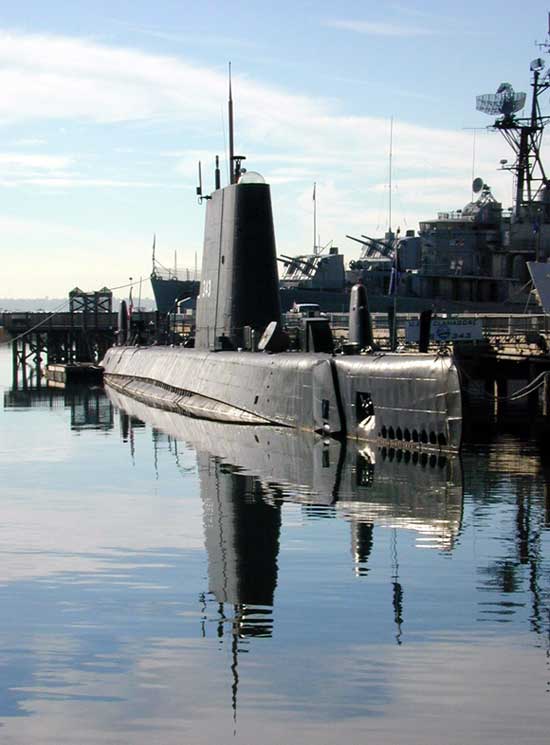
Patriots Point Naval & Maritime Museum
40 Patriots Point Road
Mount Pleasant, SC 29464
(843) 884-2727
Fax: (843) 881-4232
Email: [email protected]
Email (for overnight encampments): [email protected]
http://www.patriotspoint.org/
From Naval History Magazine Mar./Apr. 1999:
The primary goal of the Patriots Point Naval & Maritime Museum is to reach beyond the history of the four famous combat ships enshrined within at the museum and honor all the major World War II naval combatants. The museum emphasizes permanent memorial exhibits and actively has sought close ties with veterans’ reunion associations. The result is that museum visitors can experience not only life on board an aircraft carrier, destroyer, and Coast Guard cutter, but also can find the stories of battleships, heavy and light cruisers, destroyer escorts, and experience maritime history throughout Charleston, South Carolina.
The submarine Clamagore (SS-343) entered service too late to see action in World War II, but few visitors fail to tour her interior. Plaques and photographs honoring sister ships have been placed only where space permits.
Patriots Point Naval & Maritime Museum is on the east side of Charleston Harbor, just three miles from-and in sight of-Fort Sumter. The Museum is located at 40 Patriots Point Road in Mt. Pleasant, South Carolina. Hours are from 0900 to 1830 in the winter; 0900 to 2100 in the summer. Admission fee is $10 for adults; $5 for youths 7-17; free for children 6 and under. For information, call 843-884-2727.
CSS H.L. Hunley
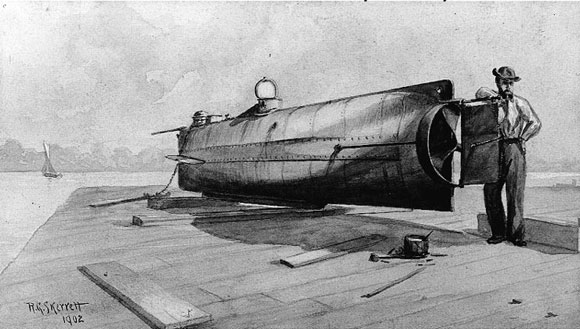
Friends of the Hunley, Inc.
Warren Lasch Conservation Center
1250 Supply Street
North Charleston, SC 29405
Phone: 843-743-4865
Fax: 843-744-1480
Email: [email protected]
http://www.hunley.org
USS Laffey (DD-724)
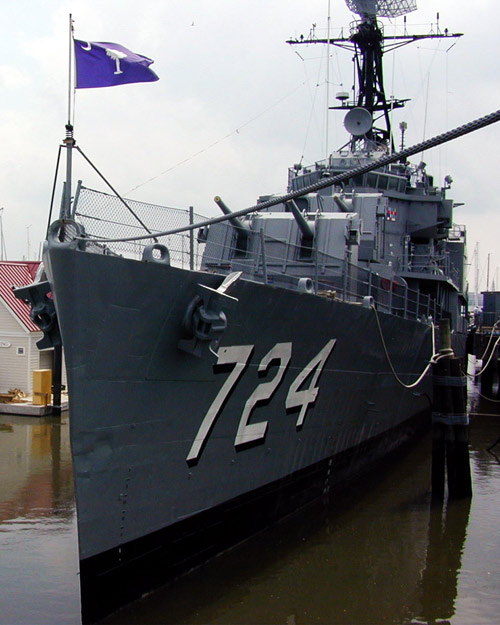
Patriots Point Naval & Maritime Museum
40 Patriots Point Road
Mount Pleasant, SC 29464
(843) 884-2727
Fax: (843) 881-4232
Email: [email protected]
Email (for overnight encampments): [email protected]
http://www.patriotspoint.org/
From Proceedings, April 2010:
Dubbed “The Ship that Wouldn’t Die” by the late Rear Admiral Frederick Julian Becton in the title of his book recalling the Laffey’s World War II history and the ferocious kamikaze attack that brought her momentary fame, the brave ship lived a long life until recently, when she faced another kind of peril: old age. Two World War II destroyers carried the name Laffey, after Civil War Medal of Honor recipient Bartlett Laffey. The first, DD-459, was lost in action off Guadalcanal in November 1942. The second Laffey was built under Becton’s close supervision at Bath Iron Works and commissioned in 1944.
USS Yorktown (CV-10)
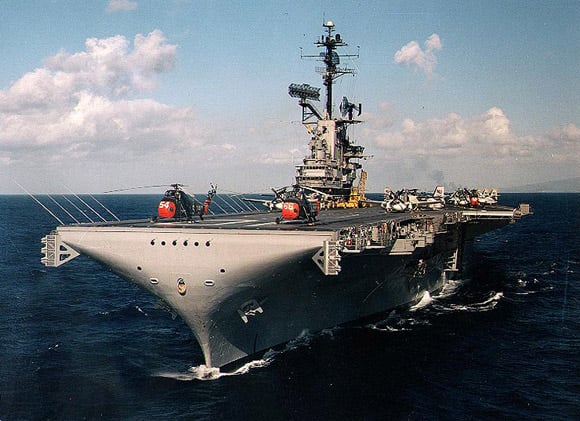
Patriots Point Naval & Maritime Museum
40 Patriots Point Road
Mount Pleasant, SC 29464
(843) 884-2727
Fax: (843) 881-4232
Email: [email protected]
Email (for overnight encampments): [email protected]
http://www.patriotspoint.org/
http://www.ussyorktown.net/
From Naval History Magazine, Mar./Apr. 1999:
The aircraft carrier Yorktown (CV-10)-recipient of the Presidential Unit Citation and 11 Battle Stars during World War II-is the flagship for the museum fleet. In addition to converting compartments into exhibit space to preserve and display her own memorabilia, some of the carrier’s compartments have been restored to their original use; others for space to display artifacts and memorabilia for sister carriers. Most of what remains of the World War II carriers Enterprise (CV-6), Franklin (CV-13), Essex (CV-9), Hancock (CV-19), Ticonderoga (CV-14), Saratoga (CV-3), Monterey (CVL-26), and others is on board the Yorktown.
The hangar deck of the Yorktown is home to a dozen famous carrier airplanes, including Wildcat, Hellcat, and Corsair fighters; two TBM Avenger torpedo bombers; and a rare SBD Dauntless divebomber. Exhibits on the hangar deck show World War II fast carriers, carrier Presidential Unit Citation winners, supercarriers, Battle of Midway torpedo squadrons, a test pilot hall of honor, and the National Memorial to Carrier Aviation-individual plaques bearing the names of more than 8,000 pilots, crewmen, and sailors lost in combat. The Yorktown‘s flight deck features jet planes from the Korean and Vietnam War eras, while large bronze plaques for naval luminaries inducted into the Yorktown Hall of Fame hang on the island.
Texas
USS Cavalla (SS-244)
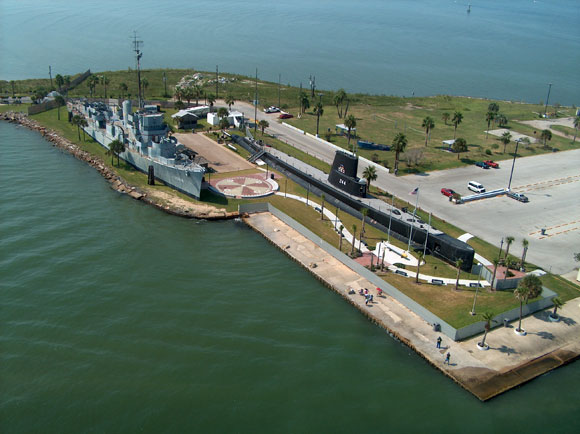
Galveston Naval Museum at Seawolf Park
Pelican Island
Galveston, Texas 77552
Email: [email protected]
https://www.galveston.com/whattodo/arts/museums/galvestonnavalmuseum/
From Naval History Magazine, Dec. 2008:
Many weeks after Hurricane Ike stormed the Texas coastline on 13 September, thousands of residents are still homeless. The plight of the region’s coastal museum ships pales in comparison, nevertheless, they too are in a recovery phase.
Seawolf Park, home of the Cavalla (SS-244) and Stewart (DE-238) and just minutes east of downtown Galveston, faced the near wont of the storm. John McMichael, the park’s curator, reported: “The Cavalla and the Stewart were both lifted from their original berths and moved. When they settled, they settled in different locations and the Stewart is sitting with a 17-degree starboard list, the Cavada has about a 3 -degree port list. Both ships will be closed until we can get them righted and sitting with a zero list.”
Neither ship suffered internal damage or leakage but outbuildings and a storage facility are gone. In early October, the museum was still closed.
Japanese HA-19
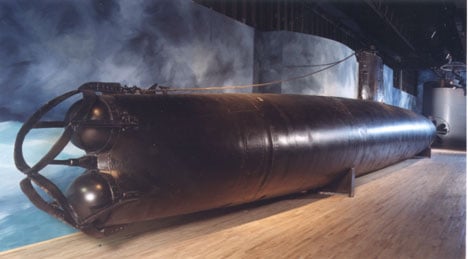
National Museum of the Pacific War
340 East Main Street
Fredericksburg, Texas 78624
(830) 997-4379
Fax (830) 997-8220
http://www.pacificwarmuseum.org/index.asp
Email: [email protected]
USS Lexington (CV-16)
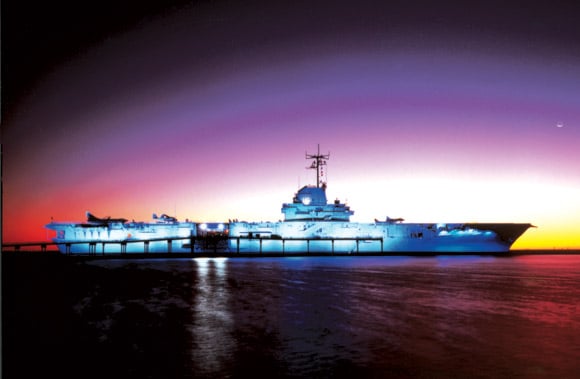
Lady Lex Museum on the Bay
2914 North Shoreline Boulevard
Corpus Christi, Texas 78402
(361) 888-4873
Fax: (362) 883-8361
Email: [email protected]
Email (for overnight encampments): [email protected]
http://usslexington.com/
From Naval History Magazine, Oct. 2010:
When searching for longevity in aircraft carrier performance, one need look no further than the former USS Lexington, now a museum in Corpus Christi Bay, Texas. Her active service lasted so long that she ran through an alphabet soup of hull numbers: CV-16, CVA-16, CVS-16, CVT-16, and AVT-16. They reflected her changing roles over the years, beginning with service as an attack carrier, later as an antisubmarine carrier, and finally as the training platform for at least two generations of naval aviators.
Her career began with commissioning in 1943 and combat service throughout the remainder of World War II. She and her sisters of the Essex (CV-9) class formed the core of the striking force that carried the war through the Central Pacific campaign and then to the Japanese Home Islands. The “Lex” was Vice Admiral Marc Mitscher’s flagship as he commanded the fast-carrier striking force during two great air-sea battles of 1944: “The Great Marianas Turkey Shoot” in June and the Battle of Leyte Gulf in October.
PT-309
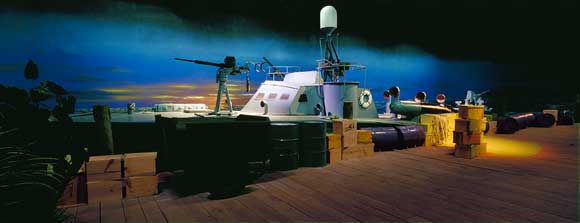
National Museum of the Pacific War
340 East Main Street
Fredericksburg, Texas 78624
(830) 997-4379
Fax (830) 997-8220
http://www.pacificwarmuseum.org/index.asp
Email: [email protected]
USS Stewart (DE-238)
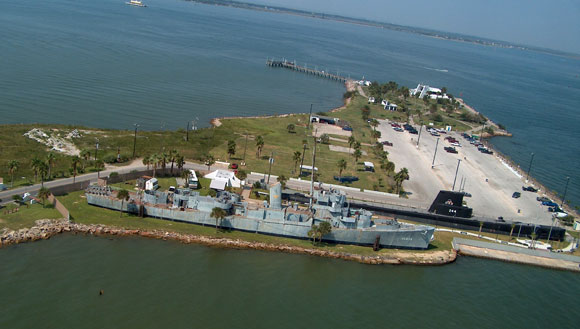
Galveston Naval Museum at Seawolf Park
Pelican Island
Galveston, Texas 77552
Email: [email protected]
https://www.galveston.com/whattodo/arts/museums/galvestonnavalmuseum/
USS Texas (BB-35)
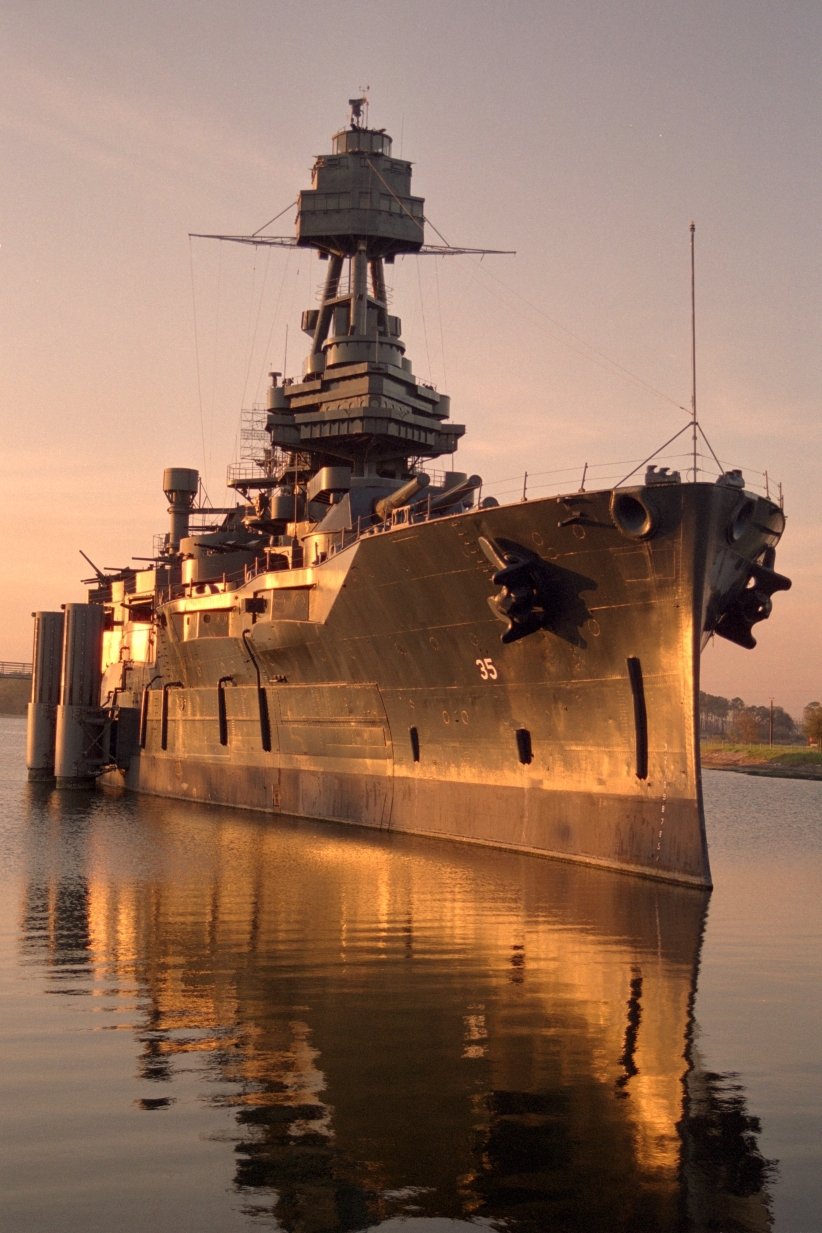
Battleship Texas State Historical Site
3523 Independence Parkway South
La Porte, Texas 77571
(281) 479-2431
Fax: (281) 479-4197
Email: [email protected]
http://www.tpwd.state.tx.us/state-parks/battleship-texas
http://www.usstexasbb35.com
For overnights:
(281) 542-0684
Email: [email protected]
http://www.battleshiptexas.org
From Naval History Magazine, Dec. 2009:
For more than 50 years, the battleship was regarded as the capital ship of the world’s navies. Hundreds were built between 1880 and the end of World War II, yet only a handful survive as museum ships. The Royal Navy, which commissioned more than 100 battleships, has astonishingly not preserved a single one. Even HMS Dreadnought, whose design was so revolutionary that her name became synonymous with the type, could not escape the scrap yard. The United States has done somewhat better in this regard, having preserved seven World War II battleships and the USS Texas, the lone extant battleship to have seen combat in both World Wars. Only one other battleship – the sole preDreadnought – is left in the world, the oldest and arguably the most significant for naval history: the Mikosa, located in Yokosuka, Japan.
Widespread public support in the 1920s led to her preservation as a museum ship. She was bombed by U.S. forces during World War II but restored a decade later with the support of public donations, the Japanese government, the U.S. Navy, and Admiral Chester W. Nimitz, who referred to Admiral Togo as Japan’s greatest admiral of whom he himself was “a great admirer and disciple.”
Virginia
USS Monitor
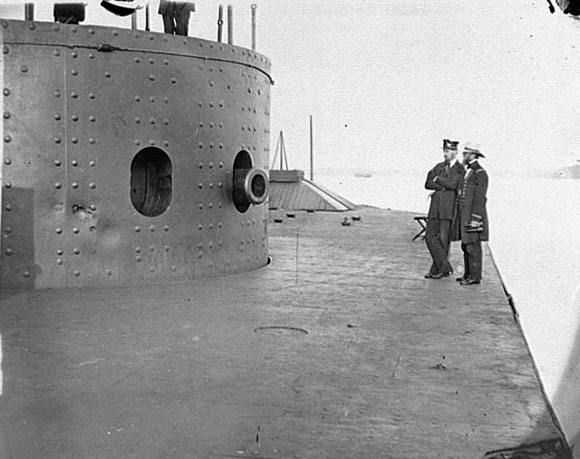
The Mariners’ Museum
100 Museum Drive
Newport News, Virginia 23606
(757) 596-2222
Fax: (757) 591-7320
Email: [email protected]
http://www.marinersmuseum.org/
From Proceedings, March 2012:
A century-and-a-half ago, as the divided nation was engaged in the bitter Civil War, the fields of battle included not only land but also the sea. In response to President Abraham Lincoln’s declaration of a naval blockade of the Southern coast from Virginia to the Gulf of Mexico, the U.S. Navy began a buildup to enforce it. Off Hampton Roads, Virginia, the Navy’s ships were in a position not only to blockade, but potentially to enter the James River and push up to the Confederate capital of Richmond. The Confederates blocked the river with sunken ships and other obstructions, including underwater mines then known as torpedoes. They also raised and repaired the half-burned and sunken hulk of the former USS Merrimack , converting it into a new type of ironclad warship. Commissioned as the CSS Virginia , on 8 March 1862, the ironclad wreaked havoc on the Union Fleet at Hampton Roads.
In a one-sided battle, the Virginia sank the USS Cumberland and set the USS Congress afire, destroying her. The age of the wooden warship was over. Fear that the Virginia might not be stopped, and that the river approaches to Washington, D.C., also accessible from Hampton Roads, might now be open to Confederate assault, Union military and political leaders were alarmed. Their only hope was a tiny, experimental craft, the Union’s ironclad USS Monitor . Built hastily in just 100 days in a Brooklyn suburb, the Monitor was untested and not trusted by some. But at the heart of that iron ship was more than steam power and two mighty guns. There were men, the type of individuals who had served and who continue to serve in the Navy and the other armed forces.
Arriving by the light of the burning Congress that evening after a harrowing voyage in which she nearly foundered in heavy seas, the Monitor took position the next morning as the Virginia returned to finish the fight. In a battle that raged for hours, the two ships, each with brave and staunch crews, hammered at each other in this first clash of armored ships. While the battle ended in a draw, a new age had dawned in naval warfare. The withdrawal of the Virginia was heralded as a victory in the North, and theMonitor became known as the ship that saved the Union. The tiny ironclad’s iconic status remained throughout the rest of her brief life, and beyond her loss on 31 December, less than a year after her launch. Under tow of the USS Rhode Island to a new field of battle, the Monitor sank in high swells off Cape Hatteras, North Carolina, that night. The stormy seas also claimed 16 of the Monitor ’s crew.
Lightship Portsmouth (LV-101 then WAL-524)
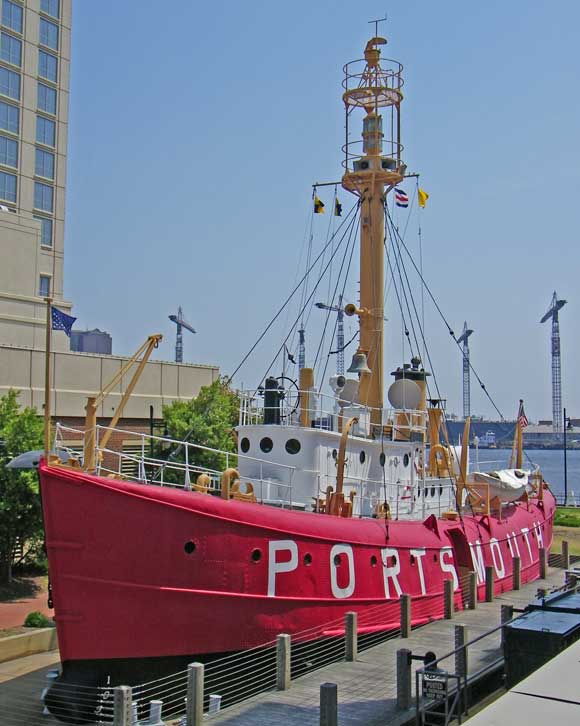
London Slip (intersection of London & Water Streets)
Portsmouth, Va.
(757) 393-8591
Fax: (757) 393-5224
Email: [email protected]
http://portsmouthnavalshipyardmuseum.com/
USS Wisconsin (BB-64)
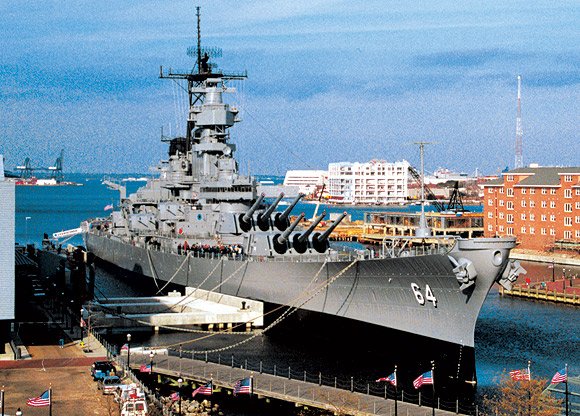
Nauticus/Battleship Wisconsin
One Waterside Drive
Norfolk, VA 23510-1607
(757) 664-1000
Fax: (757) 623-1287
Email: [email protected]
http://www.nauticus.org
Washington
Tug Arthur Foss
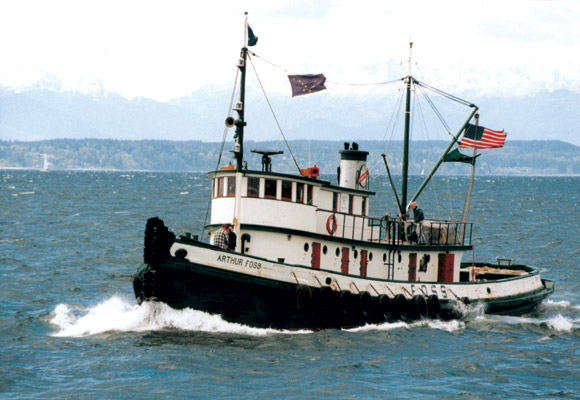
Northwest Seaport
1002 Valley Street
Seattle, WA 98109-4332
(206) 447-9800
Fax: (206) 447-0598
Email: [email protected]
http://nwseaport.org
USCGC Comanche (ATA-202)
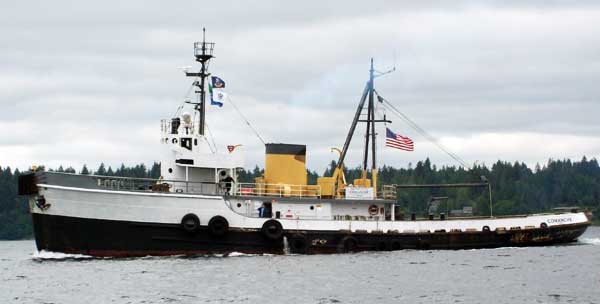
When not underway
Port of Bremerton Marina
120 Washington Beach
Bremerton, WA 98337
(253) 227-9678
Joe V. Peterson, Director of Operations
Email: [email protected]
http://www.76fsa.org/cgta/comanchee.htm
RV Deep Quest
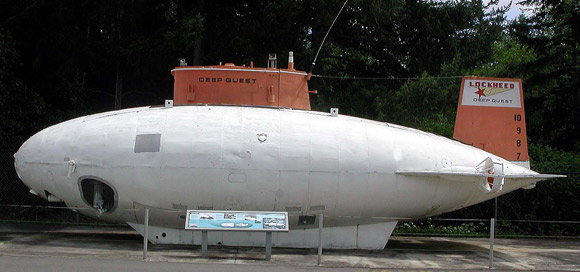
Naval Undersea Museum
Navy Region Northwest
1103 Hunley Road
Silverdale, WA 98315-1103
(360) 396-4148
Fax: (360) 396-7944
http://www.history.navy.mil/museums/keyport/index1.htm
PACV-4
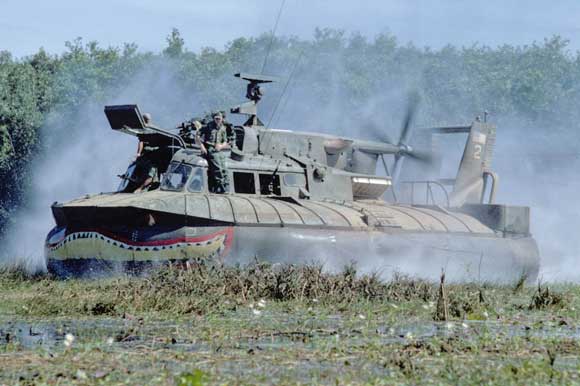
Bellingham International Maritime Museum
800 Cornwall Avenue
Bellingham, WA 98225
Tel: (360) 592-4112
Fax: (360) 592-4112
http://www.bellinghammaritimemuseum.org/
PBR Mark II
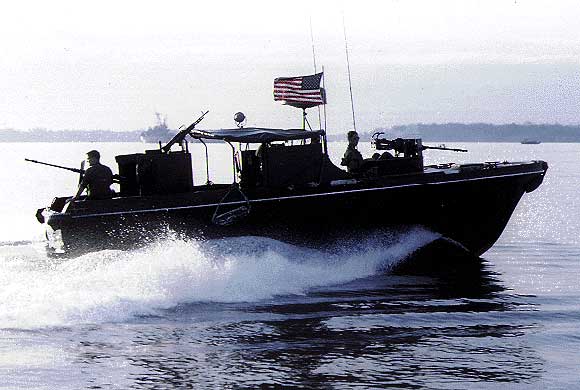
Bellingham International Maritime Museum
800 Cornwall Avenue
Bellingham, WA 98225
Tel: (360) 592-4112
Fax: (360) 592-4112
http://www.bellinghammaritimemuseum.org/
Lightship Swiftsure (LV-83 then WAL-508)
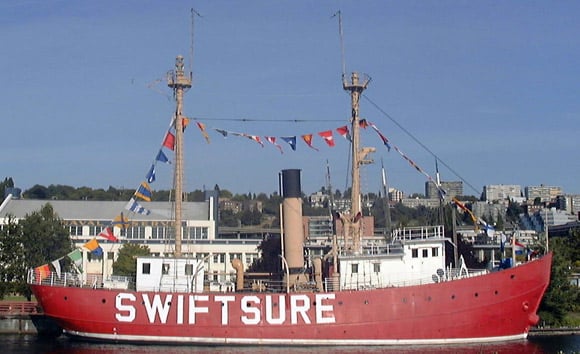
Northwest Seaport
PO Box 9744
Seattle, WA 98109
(206) 447-9800
Fax: (206) 447-0598
Email: [email protected]
http://nwseaport.org/
RV Trieste II DSV 1
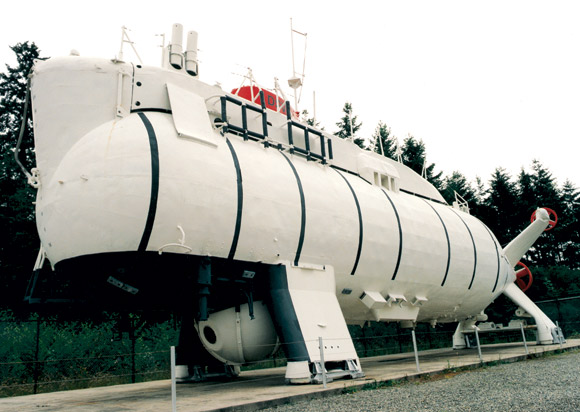
Naval Undersea Museum
Navy Region Northwest
1103 Hunley Road
Silverdale, WA 98315-1103
(360) 396-4148
Fax: (360) 396-7944
http://www.history.navy.mil/museums/keyport/index1.htm
From Proceedings Magazine, Feb. 2014:
The Trieste ’s participation in Winter Wind effectively ended on 21 May 1968 when the nuclear-powered submarine USS Scorpion (SSN-589) was lost in the North Atlantic. The covert bathyscaph was the only operational manned deep-submersible available to the Navy that was capable of diving on the Scorpion wreck. (The older Trieste II was no longer operational.) The third bathyscaph would have to come out of hiding.
During the IOU’s eastbound transit of the Panama Canal in late February 1969, the officer-in-charge of the White Sands was directed to remove the tarp covering her docking well, openly displaying the third Trieste for the first time. Subsequent to this debut, the older streamlined Trieste II was withdrawn from public view and later unceremoniously disassembled for scrap at Mare Island.
After investigating the Scorpion debris field in 1969, the IOU returned to San Diego. The bathyscaph emerged from overhaul in September 1970, and the Navy finally officially named her Trieste II , with the hull number DSV-1, designating her Deep Submergence Vehicle No. 1.
USS Turner Joy (DD-951)
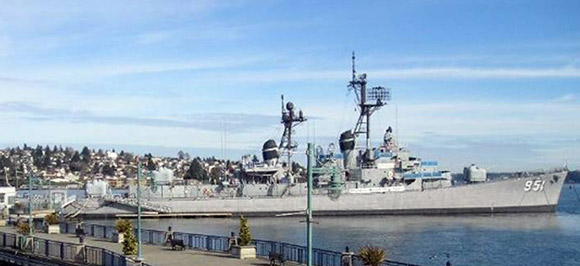
Bremerton Historic Ships Association
300 Washington Beach Avenue
Bremerton, WA 98337-5668
(360) 792-2457
Fax: (360) 377-1020
Email: [email protected]
http://www.ussturnerjoy.org/
Wisconsin
USS Cobia (SS-245)
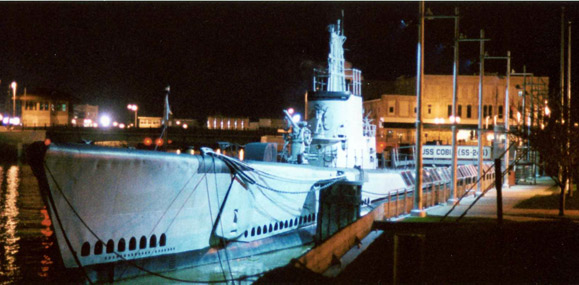
Wisconsin Maritime Museum
75 Maritime Drive
Manitowoc, Wisconsin 54220-6843
(920) 684-0218
(866) 724-2356
Fax: (920) 684-0219
Email: [email protected]
http://www.wisconsinmaritime.org/
From Naval History Magazine, Dec. 2001:
The Wisconsin Maritime Museum is located in Manitowoc, a little more than 80 miles north of Milwaukee on the shore of Lake Michigan. This section of the state is well known for its coastline, art colonies, lighthouses, hunting and fishing, and maritime industry. This museum is Wisconsin’s largest maritime museum.
During World War II, Manitowoc was the first freshwater port to build submarines; between 1941 and 1945, 28 of them were launched there. The museum honors this part of the region’s heritage with its companion vessel: the Gato (SS-212)-class submarine USS Cobia (SS-245), which has been designated the Manitowoc Submarine Memorial and a National Historic Landmark, and is listed on the National Register of Historic Places.
Tours of the Cobia, available year round, are available with the museum for a combined ticket. On the tour, lasting about 45 minutes, you can view the torpedo room, wardroom, crew’s quarters, engine room, and more. The upper deck of the Cobia is modeled as it was during her wartime career in the 1940s.
Commissioned in 1944, the Cobia served with distinction on six war patrols in the Pacific. In and out of commission after the war, the Cobia finally was transferred to the Naval Reserve in Milwaukee. She then served as a training vessel for submarine reservists for 11 years. During this time the Cobia was drydocked and her bunks were removed, in addition to other modifications, to accommodate a classroom environment
Tug John Purves
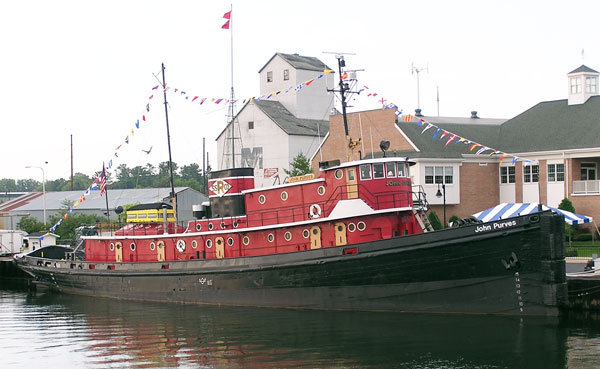
Door County Maritime Museum
120 North Madison Avenue
Sturgeon Bay, WI 54235
(920) 743-5958
FAX (920) 743-9483
Email: [email protected]
http://www.dcmm.org
